








The groundbreaking ceremony for the Teaching and Research Building (see center pages) coincided with the public announcement ofa $100-million fundraising effort by the School ofVeterinary Medicine.Entitled Building New Levels of Excellence,the campaign seeks to secure funding for the School’s strategic priorities. The centerpiece ofthis campaign is the new building,with a goal of$54 million.“This is our most ambitious fundraising campaign ever,”says Alan M.Kelly,the Gilbert S. Kahn Dean ofVeterinary Medicine.“More than 14,000 gifts and pledges have propelled us forward,and I am confident that many new donors will help us reach our ultimate goal.”
To date,the School has raised $80 million toward its goal.The campaign began in July 2000 and seeks to raise approximately $61 million for new physical spaces,$25 million for endowment,and $14 million in current operating support and planned gifts for future use.
“Beyond the Teaching and Research Building,key priorities include new endowed professorships and scholarships, faculty research support,imaging facilities for both campuses,and a new radiation therapy suite for the Ryan Hospital,” reports Mark Stuart,assistant dean for development.
Almost $10 million has been given by members ofthe School’s Board of Overseers,its top volunteer advisory group. “For a small number ofindividuals to contribute or play a pivotal role in securing this sum is staggering,”says Stuart.“The School ofVeterinary Medicine is very fortunate to have dedicated volunteer leaders who give generously oftheir time,talent,and financial resources.”
Building New Levels ofExcellence is led by chairwoman Laurie J.Landeau,a 1984 graduate and first woman to complete the joint V.M.D./M.B.A.program with the Wharton School.Landeau is also an adjunct professor at the Veterinary School serving as associate director ofAquaVet®,a summer educational program for students
who wish to pursue careers in aquatic medicine.
Serving as honorary co-chairs are Charles Raker,V.M.D.,and Josephine Deubler,V.M.D.,Ph.D. Raker is a 1942 graduate ofPenn Veterinary Medicine and a pioneering equine surgeon.Deubler is the first female graduate ofthe veterinary school (Class of1938) and the first female veterinarian to earn a Ph.D.at Penn.“With Jo and Charlie endorsing this effort,our campaign is now standing on the shoulders ofliving legends in veterinary medicine. Their combined length ofservice to the School is unrivaled,and may,in fact,add up to more years than Penn has had a school ofveterinary medicine,”reports Dean Kelly.
Recent major gifts include:
• $500,000 from Gretchen and Roy Jackson to support the Teaching and Research Building as well as an Equine Equipment Fund at New Bolton Center. Gretchen serves on the School’s Board ofOverseers.
• $125,000 from Anne (Mimi) French Thorington to establish the School’s first endowed Opportunity Scholarship which provides mentoring from alumni and faculty in addition to the financial support.The fund is named in honor of Charles Raker,one ofthe School’s most revered faculty and founder ofthis scholarship program.
• $100,000 from Muriel Freeman ofNew York City,a longtime friend ofthe School and significant figure in the dog show world, to support the Josephine Deubler Bridge for Women in Veterinary Medicine that connects the new building to the School’s existing campus.
• $100,000 from Margaret Gerhard,the founder ofGeneral Econopak,a maker ofveterinary medical equipment in Philadelphia.This gift endows a merit scholarship for students entering their fourth year ofstudy
The veterinary profession has responsibility for the health and productivity ofthe livestock and poultry populations ofthe United States. Today,many in the profession are worried about this obligation.First is the menace of agroterrorism and recognition ofthe ease with which an organism such as the foot-and-mouth disease virus could be maliciously introduced into our livestock and wildlife populations with devastating consequences to our economy and our way oflife.
A second concern comes from the threat of new and reemerging infectious diseases that are invading our shores with increasing frequency—monkeypox,SARS,mad cow disease, avian influenza,West Nile fever.They are mostly zoonotic diseases,diseases transmissible to humans.Their trespass into our animal populations is the inevitable consequence ofglobal
trade,world population growth,air travel, poverty,and squalor.It is unlikely that these ingredients will change in the foreseeable future,and foreign animal diseases will almost certainly continue to invade United States.The worry is that we are ill prepared to defend against either ofthese threats.
Government support to meet the needs for agricultural biosecurity,ifit is to be forthcoming,will come out offear ofthe unknown,from perceived threats to the food supply from diseases such as mad cow disease or avian influenza.Yet the needs for biosecurity on the farm,in the profession,and in our teaching hospitals are already here,and the threats are serious.In the past four years,multidrug-resistant Salmonella Newport has swept through the U.S.dairy industry,likely developing from the profligate use ofantibiotics.All mammals can be affected, but it is most severe in cattle and horses,for whom it can be lethal.Many seemingly normal animals carry and shed the organism,complicating its control.We have had to close the George D.Widener Hospital for Large Animals at New Bolton Center because ofan outbreak of S. Newport.

As the country’s oldest continuing education conference for veterinarians and veterinary technicians,the 104th Penn Annual Conference,held on March 11–12,2004,at the Adams Mark Hotel in Philadelphia,attracted more than 600 veterinarians and 200 veterinary technicians.In addition,280 faculty and veterinary staffand technicians,and 50 fourth-year students attended from the School ofVeterinary Medicine.
Internationally recognized speakers addressed a wide range oftopics to veterinarians in the Small Animal,Equine,and Food Animal sessions.Topics discussed this year included:Minimally Invasive Procedures,Clinical Therapeutics,Respiratory,Ophthalmology, Equine Laminitis,Making Dairy Facilities Work,Safeguarding American Agriculture, Crisis Cases in Critical Care,Dentistry,Laser Surgery,and Behavior.Small-animal technicians had a specialized two-day seminar that covered several topics,including:Understanding and Management ofDrug Therapy and Clinical Tests and Results,and Exotic Pets:
Mammals,Reptiles,and Birds.Many sessions were standing room only.
The first day ended with a well-attended Dean’s Reception hosted by Dean Alan M. Kelly.The Office ofDevelopment and Alumni Relations hosted several popular alumni and donor appreciation events:Successful Financial Planning for Veterinary Professionals Luncheon with JeffBrown, The Philadelphia Inquirer personal finance columnist,which was generously sponsored by Commerce Bank;the Rush
In humans, S. Newport causes diarrhea, pain,fever,and malaise;although not common, it is ofspecial concern in young children and may become severe in individuals who are immunosupressed.We are not aware ofany infection among faculty,staff,or students at New Bolton Center.
Without effective antibiotics,the only way to contain the spread of S. Newport is by rigorous biosecurity measures,routine disinfection,foot baths,personal hygiene,changes ofshoes and clothing as workers and veterinarians move between facilities,and limited access to animal housing.
We shall institute these measures at New Bolton Center once we have completed the arduous task ofdecontaminating our facilities. We shall also routinely culture all animals entering the hospital and isolate any that test positive for Salmonella.Our goal is to offer better,safer care than ever before at New Bolton Center and to sustain our reputation as one of the world’s premier equine hospitals.
Alan M.KellyThe Gilbert S.Kahn Dean
 ofVeterinaryMedicine
ofVeterinaryMedicine
The Conference gratefully acknowledges the financial support of sponsors,patrons,and exhibitors who sold out our exhibit hall.
Please save the dates ofThursday and Friday,March 10 and 11,for the 2005 Conference at the Adam's Mark Hotel.Pennsylvania has raised its continuing education requirement for veterinarians to 30 hours over two years, and we plan to increase the number ofcontinuing education hours available annually at the Penn Annual Conference to 15 hours,beginning with the 2005 Penn Annual Conference. Although the schedule has not been finalized yet,the Conference will remain two days in length.Please bookmark the website, <alumni.vet.upenn.edu/pennannualconference. html>,and check your mail in the winter for the 2005 Penn Annual Conference brochure.
Through the cycads and gingkoes ofthe floodplains,not far from the Sundance Sea, strode the 50-foot-long Suuwassea,a plant-eating dinosaur with a whip-like tail and an anomalous second hole in its skull destined to puzzle paleontologists 150 million years later.According to researchers at Penn, Suuwassea emilieae (pronounced SOO-oo-WAH-see-uh eh-MEE-LEEaye) is a smaller relative of Diplodocus and Apatosaurus and is the first named sauropod dinosaur from the Jurassic ofsouthern Montana. Their findings appeared in the journal Acta Paleontologica Polonica.
Suuwassea is the first unequivocal new sauropod from the Morrison Formation,a 150-million-year-old geological formation extending from New Mexico to Montana,in more than a century.It has a number ofdistinguishing features,but the most striking is a second hole in its skull,a feature we have never seen before in a North American dinosaur,according to Peter Dodson,senior author and professor ofanatomy
at Penn’s School ofVeterinary Medicine and professor in the Department ofEarth and Environmental Sciences.While its Diplodocus relatives have a single hole on the top ofthe skull related to the nasal cavity,paleontologists have yet to come up with a plausible use for this second hole.
The name comes from the Native American Crow word meaning “ancient thunder”is and also a nod to thunder lizard,the original nickname ofthe dinosaur now known as Apatosaurus. Emilieae is a reference to the late Emilie deHellebranth,whose financial support funded the dinosaur’s excavation.
The dinosaur’s skeleton was initially found by William Donawick,an emeritus professor ofsurgery at Penn’s School ofVeterinary Medicine, while horseback riding with his son-in-law Will Tillett near the family ranch in Wyoming,close to the southern border ofMontana.

At the time Suuwassea was alive,this part of
On May 10,2004,the George D.Widener Hospital for Large Animals at New Bolton Center,Penn’s large animal facility,was closed to new patients for six to eight weeks,for decontamination ofbarn and clinic buildings. Earlier this year,multidrug-resistant Salmonella infections occurred in the patient population. The administration opted for hospital closure to not expose patients to the organism and to allow for faster,more efficient decontamination ofthe buildings.The hospital will re-open after appropriate bio-security measures have been instituted to protect patients and staff.
On May 27 it was announced that the Section ofReproduction at New Bolton Center accepts patients again.The service is located in the Georgia and Phillip Hofmann Research Center for Animal Reproduction,on Bartram Road,about two miles away from the Widener Hospital.
“The Hofmann Center was closed as a precaution until the facility could be screened for contamination,”says Dr.Patricia Sertich. “Repeated screenings ofthe environment and resident animals showed that the Hofmann Center was free ofany Salmonella contamina-
tion,allowing us to safely open our doors to accept patients again.As an added precaution, clients will observe that we have implemented additional bio-security measures to continue to ensure the health ofour patients.”
The Section ofReproduction provides comprehensive reproductive care for horses, cattle,sheep,swine,goats,and llamas.Services include:breeding soundness evaluations, transported semen program,embryo transfer program,an equine embryo recipient mare herd,reproductive behavior consultations
Appointments can be made by calling 610.925.6220.Clients should drive directly to the Hofmann Center without stopping at the Widener Hospital.
The Center’s Field Service has relocated to a different part ofthe campus and continues to make farm calls.The diagnostic laboratories are open and accept samples from practitioners.
Penn’s School ofVeterinary Medicine anticipates that its Widener Hospital for Large Animals will re-open the end ofJuly after appropriate bio-security measures have been instituted to protect patients and staff.
the Morrison Formation was near the shoreline ofa long but shallow arm ofocean water called the Sundance Sea.The coastal ecosystem has not been the typical environment for Morrison Formation dinosaurs,which have mostly been found in a more arid region farther south. The discovery ofthis new species could suggest that the fauna ofthis area differed from the rest ofthe Morrison Formation or that this region was something ofa lush Jurassic “vacation spot.”
Nowadays,the region is much more arid,and much of Suuwassea’s partial skeleton was found exposed on the surface,from years ofwind and rain erosion.The partial skeleton,which was deposited randomly by river flooding before fossilization,held enough distinguishing characteristics that Dodson and his colleagues could easily classify it as a new species.
Suuwassea’s tail vertebrae are shorter and flatter at the ends than those ofits relatives,and the proportions ofsome ofthe other vertebrae and leg bones are also different,says Jerry Harris, coauthor and graduate student researcher in Penn’s Department ofEarth and Environmental Science.The extra hole in the skull is still a mystery;it has only been seen before in two dinosaurs from Africa and one from South America.It is interesting that the two African dinosaurs are exactly the same age as Suuwassea, and all three are also related to the much larger Diplodocus and Apatosaurus
Since the skulls ofsauropod dinosaurs are largely made ofthin,fragile bones,the researchers were fortunate to recover any ofthe skull at all.
For sauropods,only the bigger,heavier,and denser bones,like the limbs,are usually preserved,Harris notes.
Luck seems to be with the Penn researchers. Near the excavation site ofthe Suuwassea remains,members ofthe expedition chanced upon the partial skeleton ofa new dinosaur predator,currently under study by Penn researchers.
Funding for this research was supported by Emilie deHellebranth;Penn’s Research Foundation,School ofVeterinary Medicine,and Department ofAnimal Biology;and the Penn Paleobiology Fund.
Suuwassea emilieae is currently in the collection ofthe Academy ofNatural Sciences in Philadelphia,where Dodson is a research associate.
Ten percent. That was the chance ofsurvival that Dr.Reid Groman,director ofthe Companion Animal Hemodialysis Center at the Matthew J.Ryan Veterinary Hospital,gave the dog.On the advice ofa local veterinarian (a Penn alumnus),Gene and Mary Ellen Cole brought their 5-year-old Australian shepherd from Scranton to Ryan’s Emergency Service on Sunday,January 11 with severe acute kidney disease.
Several days before,during an evening walk, Zeus had nosed around briefly in a neighbor’s trash,which had already been gnawed open by rummaging animals.Shortly afterward,the dog mysteriously began to exhibit symptoms ofillness,particularly fever and loss ofappetite. “After he wouldn’t eat his dinner,I bought Zeus vanilla ice cream,his very favorite food,and when he turned his head away,I knew something was wrong,”recalls Mrs.Cole.He also was making very little urine and was getting progressively sicker and puffier.There was no doubt that Zeus was in trouble.
Zeus failed to respond to aggressive fluid therapy and medical management ofhis renal failure.He was uncomfortable,nauseated,and his urine production had all but ceased.At 77 pounds,Zeus was almost nine pounds overweight,all attributable to excess fluid that his failing kidneys could no longer eliminate.Zeus developed progressive swelling and edema in his limbs,abdomen,and face.More worrisome, however,was Zeus’s labored breathing.Following a series oftests,it was determined that Zeus had uremic pneumonitis,a form ofthe acute respiratory distress syndrome infrequently encountered in veterinary medicine.The very sick dog was transferred on Monday to the Intensive Care Unit,where he was ultimately diagnosed with a bacterial infection known as leptospirosis.Caused by germs spread primarily through rodents’urine,the disease can severely damage the liver and kidneys ofdogs,humans, and other animals.Sometimes there are no symptoms,although some dogs can pass the bacteria in their urine for up to one year.This time,however,the once-indefatigable Zeus was fighting for his life.
Immediately following the placement ofa dialysis catheter,Zeus was transported to the Hemodialysis Center for his first treatment.Still anesthetized,Zeus was connected to a ventilator while simultaneously undergoing hemodialysis

(a process that removes toxins from the blood), the first ofsix 5-hour dialysis treatments over the course ofthe next week.“We set a time limit for Zeus,”explains Dr.Kim Slensky,a third-year resident in Emergency and Critical Care who served as Zeus’s attending clinician.“I talked to his owners the second day he was here.Since he had to be on both the ventilator and hemodialysis,we were going to give him 24 hours.If he got better,fantastic.Ifhe got worse at any time,we decided we would put him to sleep.”
To everyone’s astonishment,Zeus started to get better—progress initially was slow,but it was sure.“There is no precedent—ever,anywhere—for a dog requiring simultaneous renal replacement therapy [hemodialysis] and ventilatory support to leave the hospital,”says Dr.
urine output by hydrating him intravenously until his kidneys could function normally.For testing purposes and to prevent contamination, that “output”had to be collected by scrambling nurses and doctors holding out whatever container happened to be closest.When Zeus was especially prolific,there were the mops.
Zeus’s extraordinary will to live endeared him to the Ryan staff,but it was his intelligence and irrepressible personality that earned him the reputation ofbeing quite a character.The dog absolutely,positively would not stay in a cage—in the I.C.U.or anywhere else.An offwhite couch in the Hemodialysis Center suited him best—and ifanyone foolishly attempted to move him,he would tear down the hall, hooked-up equipment rolling behind,and promptly plunk himselfback onto the sofa after a clumsy leap.
Groman.“This was no easy save.Something was in the stars for this dog.I suppose we cannot rule out—don’t laugh—some divine intervention in Zeus’s case.”Only fitting,ofcourse, for a dog who shares a name with the king of Greek gods.
Compassionate,round-the-clock care undoubtedly played a part in the shepherd’s seemingly miraculous recovery.For Dr.Slensky, 14-hour days—spent primarily on the many procedures Zeus required—were not uncommon during this time.“Dr.Slensky was absolutely superb,”says Mrs.Cole.“She gave us the strength to put Zeus on dialysis and the respirator.She didn’t make any promises,but she did give us hope.”
As Zeus steadily improved,he went from producing almost no urine to making too much,typical ofrecovery from this kind ofkidney disease.Doctors kept up with the excess
At one point, Zeus refused to eat for several days.Ryan stafftried tempting him first with turkey, then with chicken, but to no avail.Upon hearing the news,the owners asked matterof-factly,“Have you tried marshmallows?”The doctors were skeptical;why would a dog who refused the most delicious meaty tidbits accept a spongy blob ofsugar? Sure enough,though,when the owners tossed a marshmallow in the dog’s direction,he immediately caught and devoured it—all ofthis while in a harness,on a table,undergoing dialysis.After that,marshmallows,which had been a special treat at home,were added to the food du jour until more traditional doggy fare appealed once again.
Finally,on February 8,after nearly a month, Zeus was discharged from the Ryan Hospital,to resume his normal life on the Coles’horse farm.Arriving early that morning,the owners were ecstatic to be reunited with a healthy,spirited Zeus.“He was so thrilled to get in the car and come home.Not that he wasn’t treated wonderfully at Penn! But he missed running in the yard.He missed his home.And now he’s just like the old Zeus again!”
Americans,it seems,are a pet-happy lot. According to a recent survey by the American Pet Products Manufacturers Association,77 million cats,65 million dogs,17 million birds, 16 million “pocket pets”(rodents,ferrets,rabbits,and more exotic species),9 million reptiles, and approximately 200 million aquarium fish are kept as pets in the United States—triple the country’s pet population in the mid-1960s.Even considering that the human population has grown during that same period, there still are twice as many dogs and cats per American today than in 1967.And all ofus millions ofpet owners share an almost-universal trait:we anthropomorphize our pets—we attribute human thoughts, feelings,and motivations to them. We give them human names,regard them as family,provide them with the best nutrition and medical care,and often experience devastating griefwhen they die.But why do we do this? What purpose does it serve?
These are among the questions that Dr. James Serpell,Marie A.Moore Professor of Humane Ethics and AnimalWelfare,and his colleagues study every day at the multidisciplinary Center for the Interaction ofAnimals and Society (CIAS).The Center was founded in 1979 (and re-established in 1997) on the belief that there is something both special and therapeutic about the relationships people have with animals,and that animal welfare issues are a significant concern.Because this is a still-developing field that straddles traditional academic disciplines,the CIAS strives for an interdisciplinary approach,drawing in scholars and researchers from a wide variety ofdifferent backgrounds and interests.
The CIAS seeks to further our understanding ofhuman–animal interactions and relationships,including those occurring with animals in homes,farms,laboratories,zoos,and the wild.More specifically,the CIAS studies how relationships with animals influence our health and well-being,investigates the impact ofthese relationships on the animals,and encourages discussion on the ethics ofanimal use—and applies knowledge gained from this work to benefit people and promote humane
treatment ofanimals.
So,again,the question is,why do so many of us keep pets? The answer is at once simple and obvious:companion animals add important dimensions to our lives.Researchers have shown that,among other benefits,pets can help us feel less lonely,more effectively handle stress, and survive heart attacks.Given all this extraor-
junction with the School ofSocial Work,which teaches children about the responsibilities of adopting and caring for pets.The program began visiting schools in November 2002,and hundreds ofchildren have already participated.

The CIAS also periodically hosts conferences geared toward people who work in a wide range ofhuman services and animal care fields. This year’s conference, Can Animals Help Humans Heal? Animal-Assisted Interventions in Adolescent Mental Health,took place on March 28.Experts in the fields ofhealthcare,social services,psychology,and education presented on topics such as “Animals in the lives ofadolescents:A biocentric perspective on development,”“The effectiveness ofequine-facilitated therapy with at-risk adolescents,”and “Animalassisted therapy for at-risk youth and families.”
dinarily rich information,the CIAS has actively committed itselfto three types ofprograms— community outreach,education,and research.
One ofthe Center’s most visible community outreach programs involves a partnership with Penn’s School ofSocial Work.Together,the two provide griefand pet loss counseling,referral services,and a support group to clients and nonclients ofthe Ryan Hospital.Another ongoing public service project involves bringing in an evaluator from Therapy Dogs International to the School to certify handler–dog teams so that they may visit schools and various healthcare facilities.Pets are particularly therapeutic for the elderly or infirm,who have become socially isolated.According to Therapy Dogs International, “The dogs bring sparkle to a sterile day,provide a lively subject for conversation,and rekindle old memories ofpreviously owned pets.”
The CIAS has developed a seven-week Careers Working with Animals educational program that teaches students about animal-related careers,including veterinary medicine and nursing,humane education/shelter work,laboratory animal science,dog training,and careers at the zoo. Kids Caring for Pets also is an educational program developed by the CIAS,in con-
Ofthe thousands ofdogs bred each year by guide and service dog agencies,more than half fail to graduate as working dogs,mostly due to behavior and temperament problems.In collaboration with several national guide and service dog agencies,the CIAS is involved in projects that seek to clarify developmental and genetic causes ofthese problems in potential working dogs.
Behavioral problems in companion dogs are the largest single cause ofcanine abandonment, relinquishment to shelters,and premature euthanasia in the United States.The CIAS investigates behavior problems in pet dogs, focusing on the role that early experience may play in their development.To evaluate dogs’ temperament and behavior in a standardized way,the CIAS has developed a unique questionnaire (C-BARQ©) for dog owners and handlers.Already,several national guide and service dog organizations have adopted the CBARQ© as a routine behavioral screen.
Through these programs—and others—the CIAS continues to make tremendous progress in helping us understand more about our unique relationships with animals and the mutual benefits ofhuman–animal interactions. Ifyou would like more information on the CIAS or its programs,contact Dr.Serpell,director,at cias@lists.vet.upenn.edu,or go to the Center’s website at <www.vet.upenn.edu/ research/centers/cias/index.html>.
Amy Gutmann,the Provost and Laurance S. Rockefeller University Professor ofPolitics and the University Center for Human Values at Princeton University,was elected the University ofPennsylvania’s next president by Penn’s Board of Trustees at its February 20, 2004 stated meeting.
Gutmann, 54,will succeed Judith Rodin, CW’66, on July 1.Rodin announced last June that she planned to step down after serving as Penn’s president since 1994.Gutmann’s inauguration as Penn’s ninth president will be held on October 15,2004.
“Amy is a brilliant scholar with a demonstrated commitment to undergraduate and graduate education,a proven and skilled administrator who understands the challenges ofrunning a major research university and an articulate spokesperson about the essential role ofhigher education in our lives and in the future ofour society,”said James S.Riepe,chair ofPenn’s Trustees.
“She has established an extraordinary record ofachievement during her more than 25 years at Princeton,most recently as Provost. She is widely regarded as a world-class scholar whose research addresses many ofthe key issues facing our society today—from religious freedom,to race and affirmative action,to ethics and public affairs.As Dean ofthe Faculty,she was hugely effective in attracting excellent faculty to Princeton.Colleagues speak of her with the highest regard:‘fair and evenhanded,courageous and willing to take on tough problems,’‘renowned for doing her homework, ’‘there are no limits to what this person can achieve.’We are confident that Amy is the ideal person to lead Penn forward into the next stage ofits evolution.”
Gutmann said she was “tremendously excited to be given the opportunity to lead one
ofour nation’s oldest and most distinguished research universities.”
“Penn has enormous energy and a dynamic spirit,”she said.“It has extraordinary academic programs that span 12 schools,all ofwhich are located together on one beautiful urban campus.Under Judy Rodin’s leadership,Penn has established itselfin the top rank ofinstitutions, well positioned to face the opportunities and the challenges that lie ahead.I look forward with great enthusiasm to working with faculty, students,staff,alumni and other members of the Penn family to help the University build upon its tradition ofexcellence in teaching, research and public service.
“I am also looking forward to moving to the great city ofPhiladelphia,“ said Gutmann, “with its wealth ofcultural and historic institutions,and to becoming an active citizen of Penn’s vibrant West Philadelphia community.“
Riepe noted that the Board ofTrustees strongly believes it has found in Gutmann “someone to expand upon the phenomenal momentum the University has experienced during the last decade … a dynamic leader who is both a renowned scholar and skilled administrator … a champion ofinnovative academic ventures with a proven ability to recruit faculty ofthe highest stature … someone who will grow Penn’s financial resources,enhance our entrepreneurial opportunities,and capitalize on our many strengths.”
Gutmann has been Provost ofPrinceton since September 2001,serving as the University’s chiefacademic and chiefbudgetary officer, reporting to the President.She is responsible for long-range planning and for the coordination ofthe administrative and support functions ofthe University with its academic purposes.
A faculty member at Princeton since 1976, she has taught political philosophy,democratic theory,the history ofpolitical thought and practical ethics.
Gutmann received her B.A.from Radcliffe College,her M.Sc.from the London School of Economics and her Ph.D.from Harvard University.

The American College ofLaboratory Animal Medicine/American Society ofLaboratory Animal Practitioners program committee is planning “United States/United Kingdom Perspectives on Animal Welfare Issues,”a three-hour session on the morning ofMonday,July 26.Distinguished speakers will give their perspectives on how animal welfare initiatives and public,legislative,and lawyer-driven pressures may affect many aspects ofthe veterinary profession in the United States and United Kingdom.
Chaired by Margaret Landi,V’79,Global Vice President ofLaboratory Animal Science for Research and Development at GlaxoSmithKline,the speakers include a legislator from the United Kingdom,advisers to the governments ofthe United States and United Kingdom,senior academics,and former presidents ofthe AVMA and British Veterinary Association.The sessions and speakers are:
• How Legislators and Lawyers Are Having an Impact on the Role and Responsibilities ofVeterinarians:Dr.John A.Shadduck,dean emeritus ofTexas A&M University College ofVeterinary Medicine (U.S.),and Lord Soulsby ofSwaffham Prior (U.K.).
• How Lobbyists and Activists Are Having an Impact on Society’s Relationship with Animals: Jacqueline Calnan,M.P.A., president ofAmericans for Medical Progress Educational Foundation (U.S.),and Dr.Tim Morris,president ofthe European College ofLaboratory Animal Medicine (U.K.).
• Commercial Pressures on Veterinary Practice Arising from Legislation, Education,Costs,Lobbying,and Activism: Dr.Joe M.Howell,AVMA Immediate PastPresident (U.S.),and Dr.Brian Hoskin, British Veterinary Association Past President (U.K.).
For more information,please contact Dr. Landi at (610) 270-6466 or via email at <margaret.s.landi@gsk.com>.
 by Helma N.Weeks
by Helma N.Weeks
Your middle-aged,small terrier,a Westie, Norwich,Cairn,or other short-legged breed, seems to not have as much stamina as it used to have.It pants and lags on longer walks,the tongue sometimes looks not as pink as it should,and the dog coughs intermittently. Otherwise,the dog seems fine.It eats,doesn’t drink excessively,but you have a nagging feeling that all is not well.
When the vet checks the dog out,crackled sounds are heard in the lungs.The dog could have a chronic lung disease known as idiopathic pulmonary fibrosis.This disease has been identified in West Highland white terriers and to a lesser degree in other terrier breeds.It affects middle-aged and older dogs and is characterized by exercise intolerance,shortness ofbreath, difficulty in breathing,coughing,and crackled sounds on lung auscultation.The disease progresses slowly and is ultimately fatal.In the disease process,fibrous scar tissue gradually replaces functional lung tissue.Very little is known about the causes ofthe disease,but a genetic component is suspected,given the higher occurrence in certain breeds.There is a similarly devastating form ofpulmonary fibrosis in people that has become a focus ofintense research.
Recently,veterinary specialists in respiratory diseases and imaging from the U.K.and the U.S.have joined their efforts to improve the diagnosis ofpulmonary fibrosis.The AKC
Last summer,alarmed by a surge in rabies cases reported in Pennsylvania in 2002 (especially among raccoons),officials at the Commonwealth’s agriculture department decided they needed to take action.In mid-2003,the Oral Raccoon Rabies Vaccination (ORV) program was initiated in all or parts of16 western Pennsylvania counties where rabid raccoons were most prevalent.Fixed-winged airplanes or helicopters dropped vaccine-laden fishmeal bait into sparsely populated areas,and trained employees targeted densely populated areas by hand.
Results reported in February 2004 were encouraging:the number ofinfected raccoons dropped from 288 in 2002 to 232 in 2003,a 20 percent decrease.A total of428 animals tested positive for rabies in 2003,down from 492 animals in 2002—a 13 percent decline.(The 2003
Canine Health Foundation and the West Highland White Terrier Foundation ofAmerica are funding a multicenter study at the veterinary schools ofthe Universities ofPennsylvania and California,Davis in the U.S.,and the Universities ofEdinburgh and Glasgow in the U.K.At Penn’s School ofVeterinary Medicine,this project is guided by Dr.Lesley King,professor ofcritical care,and Dr.Tobias Schwarz,assistant professor ofradiology.
“Although pulmonary fibrosis in dogs,often referred to as ‘Westie lung disease,’has been recognized by breeders and veterinarians in the U.S.and U.K.for many years,it remains a huge challenge for the patient,owner,veterinarian, and breeder ofWest Highland white terriers,” says Dr.Schwarz.“Currently,accurate diagnosis requires a lung biopsy.Treatment options are limited to alleviation ofclinical signs and control ofconcurrent pneumonia.
“The study hopes to establish pulmonary computed tomography as a specific diagnostic modality in dogs,which would allow the detection ofdisease in the early stage,when therapeutic approaches are most promising,decreasing the need oflung biopsies.High-resolution computed tomography ofthe lungs is the diagnostic modalities ofchoice for pulmonary fibrosis in people and showed already promising first results in dogs.”
During the duration ofthe study,West Highland white terriers with suspected pulmonary fibrosis will receive an extensive clinical
work-up,including radiography,echocardiography,bronchoscopy,bronchial lavage, computed tomography,and a minimally invasive endoscopic lung biopsy.Genetic sample material will be collected for further analysis.
Veterinarians who wish to refer West Highland white terriers with suspected pulmonary fibrosis should call Dr.King or Dr. Schwarz directly at (215) 898-4680.The procedure is free ofcharge to the owner,and the completeness ofthe work-up offers an optimal basis for best treatment options and prognosis.
results break down as follows:232 raccoons,80 skunks,42 cats,36 bats,29 foxes,3 cattle,3 horses,1 bobcat,1 deer,and 1 groundhog.) In an effort to bring the numbers down even further,agriculture officials plan to extend the ORV program in 2004 to include the Westmoreland–Somerset county border.
Rabies,a viral disease affecting the central nervous system ofmammals,causes a progressive inflammation ofthe brain—and is always fatal to both animals and humans once symptoms ofthe disease develop (unusual behavior, aggression,drooling,depression,partial paralysis).In the United States,wildlife is primarily affected;domestic animals usually are exposed by contact with infected wild animals.In recent years,raccoons in the eastern United States have been severely affected.Rabies can be spread
Computed tomographic image of a dog with pulmonary fibrosis at the level of the tracheal bifurcation (TB).There is fibrosed lung tissue in the ventral parts of the lungs (straight arrow) and fibrin scars originating from the pleural surface (curved arrow).A main goal of the clinical study is to determine characteristic computed tomographic findings of pulmonary fibrosis.
through saliva,bites or scratches,and abrasions. Humans can contract the virus through either domestic or wild animals.
Given these statistics,routine vaccinations for all dogs and cats are more important than ever.Ofthe 42 cats reported infected in Pennsylvania,the majority were most likely barn cats,who had regular daily exposure to wildlife in rural areas.Not a single case ofrabies in a dog was reported,only proving how effective widespread canine vaccinations against the virus have been.Penn’s School ofVeterinary Medicine recommends vaccinating kittens against the virus at 12 to 13 weeks,again at 15 months,and every three years thereafter.For dogs,the School recommends rabies vaccinations at 13 to 16 weeks,at 15 months,and then, again,every three years.
It’s the stuffofbeer and bread.For thousands ofyears,this fungus has been instrumental in producing and conserving food because ofits ability to ferment glucose to ethanol and carbon dioxide.But most people do not know that this simple,single-celled organism also is a powerful model system for biological research. Cheap and easy cultivation,short generation time,detailed genetic and biochemical knowledge gained through many years ofresearch, and ready application ofmolecular techniques for its genetic manipulation—all make this versatile organism highly suitable for the study of basic biological processes relevant to many other higher organisms,including humans.
Although yeast cells are obviously much simpler than humans,they follow the same basic principles ofreproduction:first,cells must accurately duplicate their chromosomes and segregate them to opposite poles ofthe cell, and then the cells physically split into two, yielding a new generation ofgenetically identical cells.Errors in cell division can result in cellular death,lead to developmental defects,or cause cancer.Indeed,a major hallmark ofcancer cells is unrestrained cell division,which is why cancer is often considered a disease ofthe cell-division cycle.Thus,to understand the molecular mechanisms ofcancer,it is critical to resolve the processes that regulate cell division.
The laboratory of Frank Luca, assistant professor ofanimal biology,uses multidisciplinary approaches,including yeast genetics and cellular and molecular biology,to study cell-cycle regulation ofeukaryotic cells (those with dis-
tinct membrane-bound nuclei).Working with yeast,Dr.Luca discovered the “Mob”gene family,which encodes essential proteins that regulate critical aspects ofcell division and cell development.
Yeast cells offer several advantages over human cells for cell-cycle research.Yeast divide much more rapidly and are less complex than mammalian cells.Yeast,for example,divide every 90 minutes and contain only two Mob proteins,while the most rapidly dividing human cells divide every 24 hours and express up to seven Mobs.Moreover,the yeast genome is much easier to manipulate in vivo.Yeast genes can be mutated to alter the function of any protein.The observed cellular consequences ofgene mutations help reveal the function ofthe encoded proteins.“With yeast,we can perform a lot ofmolecular and genetic ‘tricks’to identify important regulatory pathways.And nearly everything we learn is transferable from yeast to humans,”explains Dr. Luca.
Thus,researchers are able to conduct experiments in yeast that elucidate biochemical signals that control growth and division in human cells.Use ofmodel organisms,such as yeast,is critical for cancer research.Thus far,Dr.Luca’s work reveals that yeast Mob proteins are components ofconserved regulatory circuits that ensure the proper timing and fidelity ofcell division.His work has led to several models regarding the function ofhuman Mob proteins that his lab is currently testing.
So,can lowly yeast hold the key in eventually discovering a cure for cancer? “Well,we’re con-
Horses,like people and other animals, may suffer from skin disorders.Similar to cats and dogs,they may manifest allergic diseases (most commonly to insects) with the development ofskin lesions,including intense itch,hives,and bumps.To assist the clinicians at New Bolton Center in the treatment ofequine skin diseases,faculty veterinary dermatologists offer appointments for horses and large-animal patients twice monthly at New Bolton Center.

Drs.Rosario Cerundolo and Daniel Morris,board-certified veterinary dermatol-
ogists and assistant professors ofdermatology at the School,and dermatology residents Drs.Jeanne Budgin and Karen Farver,hold clinics at New Bolton Center two Thursdays each month.All are based at the Matthew J. Ryan Veterinary Hospital,where they treat companion animals and special species.The clinicians have an interest in equine skin disorders and look forward to consulting on cases with the NBC staff.
Appointments for consultation with the Dermatology Service at New Bolton Center may be made by calling 610-444-5800.
centrating on diagnostics first,”responds Dr. Luca.“Like a malfunctioning automobile,you can’t effectively fix it unless you know something about how it works.At this point,we’re just trying to understand how normal cell division works.It is our hope that our work will identify novel targets for the development of new anti-cancer drugs.”
Here are some tips to keep pets healthy during the hot weather:
Dogs and cats need a cool,shady place to sleep in during hot weather and access to plenty ofclean,fresh water.Feeding time should be moved to the cooler hours ofthe day.Older animals have a harder time in hot weather,be sure they have a comfortable,cool place during the hottest hours ofthe day.
Do not take the dog jogging during the day in hot weather as the animal will overheat quickly.Ifyou want to go running with your pet,do it very early in the morning or at night when it is cooler.Even then,ifit is hot and humid,don’t do it.
Heatstroke is life threatening for dogs. Signs to watch for are:heavy,loud breathing,staggering gait,bright red gum tissue and tongue.Ifheatstroke is suspected, seek veterinary care quickly as this is a medical emergency.
“Although we focus on a single area ofeducation,the funding we provide has a much more profound effect.The veterinary students oftoday will become the doctors,technicians,and research scientists oftomorrow,and their work will lead to many advancements that ultimately extend beyond animals to benefit humanity.”
—from the Irwin Foundation website
As the very first foundation to sponsor an Opportunity Scholarship,the Irwin Foundation has a single,focused purpose— helping veterinary schools and the students who attend them.The Foundation provides funding only to accredited schools within major universities,but scholarship recipients are chosen by the universities themselves.
Regina Pellegrin,V’04,the Foundation’s recipient ofPenn Veterinary Medicine’s Opportunity Scholarship,graduated this year. During all ofRegina’s time here,the Irwin Foundation Opportunity Scholarship did much to ease her financial burden and gave her the priceless gift offaculty mentorship,a unique relationship often continuing for many years.
Like many veterinary students,Regina recalls a lifelong veterinary ambition.“I have wanted to be a veterinarian for as long as I can remember.This is what I feel I am meant to do. My first job was as a room assistant at a general practice,from the time I was 16 years old until I was 20.For the past five years,I worked as an emergency nurse at a veterinary emergency and referral center in Valley Forge,Pa.I fell in love with emergency work.I am hoping to work in
emergency medicine after graduation.I love the feeling ofhelping and consoling animals during their greatest times ofdistress.
“The Irwin Foundation’s scholarship has meant so much to me—not only in helping reduce some ofmy debt,but in allowing me the rare opportunity to have a mentor here.That kind ofsupport has just made all the difference in my educational experience at Penn Veterinary Medicine.”
The Foundation,located in Southfield, Mich.,initially concentrated its efforts in veterinary medicine.In 1997,however,it began to direct some attention to veterinary technology and the lack ofscholarships available to students seeking careers in this critical field.Since then,the Foundation has made several significant contributions designed to assist future veterinary technicians.
The Irwin Foundation also supports a variety ofprograms administered by veterinary schools as part oftheir educational mission, and it continually seeks new and innovative ways to enhance the learning experience.The types ofsupport include cash donations for established programs,purchases ofequipment and other items,and service contributions.
The Irwin Foundation is a legacy to two well-known educators in the Detroit area.Dr. James Irwin was an administrator at Detroit Public Schools and Dr.Claire Irwin was a professor at Wayne State University.Husband and wife,they both passed away in 1994.
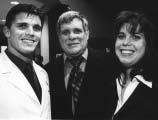
Note:The Irwin Foundation has renewed their Opportunity Scholarship,which will be awarded to a member ofthe Class of2008.
Margaret Gerhard,a long-time friend of the School and owner ofthree Labrador retrievers,made a gift of$100,000 to establish the Margaret Gerhard Endowed Merit Scholarship Fund.“This gift is made in honor ofyour highly esteemed and dedicated faculty and teaching staffat the Matthew J.Ryan Veterinary Hospital and at the one and only New Bolton Center,”said Ms.Gerhard to Dean Alan Kelly when she presented the check.“It is my wish and desire that the income from the Margaret Gerhard Merit Scholarship Fund will continuously reward and recognize the recipients for a job ‘well
The White Coat Ceremony,a tradition from medical schools and first introduced in 2001 at Penn Veterinary Medicine,was held for the Class of2005 in Houston Hall on December 9,2003.Many relatives and guests ofthe students attended the ceremony and the reception that followed.

The ceremony marks the end ofthe students’training in the classroom,and the beginning oftheir clinical rotations,where they will apply the knowledge they have learned during the first two-and-a-half years oftheir four-year veterinary education.The evening also marked the final time the entire class would be together formally before Commencement on May 16,2005.
Speakers included Dean Alan M.Kelly; faculty members; Michelle Rosero,V’04, class president; Michael R.Moyer,V’90, president ofthe Pennsylvania Veterinary Medical Association;and Christine Bohn, V’02,who spoke on behalfofthe School’s Veterinary Medical Alumni Society. W. Southard Jones,Jr.,V’71,and Courtney Jones,V’98,spoke on “The Family:Sharing Commitment.”Their son and brother, respectively,Luke,is a member ofthe Class of2005.
Sponsors ofthe ceremony included the Pennsylvania Veterinary Medical Association and its local constituent veterinary medical assocations:Brandywine,Capital City,Lehigh Valley,Northwestern,Suburban,and Western.The Veterinary Medical Alumni Society gave the students Penn brass pins to wear on their white coats.
done!’and as such,encourage and inspire optimism,dedication,and hard work in other fellow students—to heal and help a wounded world with compassion and love for all animals.”
Equine Cushing’s disease has been identified as the most common cause oflaminitis among horses in a primary care veterinary practice. The recent study by Mark T.Donaldson,V’93, assistant professor ofmedicine,was published in the April 1,2004 issue ofthe Journal ofthe American Veterinary Medical Association
The study showed the most common cause oflaminitis among horses seen at New Bolton Center was pituitary pars intermedia dysfunction,also known as equine Cushing’s disease (ECD).In ECD the pituitary and adrenal glands produce abnormal amounts ofhormones that play a vital role in the regulation ofmetabolism and inflammatory and immune responses.
All horses that developed laminitis during a six-year period (1996–2002) were tested for ECD by evaluation ofplasma ACTH concentra-
A very unusual patient visited the Ryan Hospital on April 23.A six-inch,two-yearold female seahorse was brought to the Hospital by veterinarians from the National Aquarium in Baltimore.The seahorse had a pea-size growth on its pectoral fin,near the gills.“Last October we removed a mass by conventional surgery,”said Dr.Caryn Poll of the National Aquarium.“But the mass grew back and we are here to have it removed by laser surgery.”
Chick Weisse,V’98,lecturer in surgery, enjoys working with marine animals and has performed numerous surgeries on fish. The little seahorse was his first patient ofthe Hippocampus variety.

The animal was anesthetized in water;it took about five minutes for it to become unconscious.Then it was removed from the water and placed on the table,and Dr.Poll carefully syringed water over the gills while Dr.Weisse used the tiny laser probe to remove the tumor.He then used the laser to ablate the tumor bed in the hope ofremoving any remaining cancer cells that could regrow.“Seahorses have a bony layer within the skin,called osteoderm,so one can’t just cut away the tumor without leaving a large defect,”said Dr.Weisse.“The laser removed the layer ofcancer cells while sealing the
tions.ACTH is one ofmany hormones secreted in excess by the dysfunctional pituitary gland. Twenty-eight ofthe 40 horses with laminitis were diagnosed with ECD.Although ECD is considered a disease ofolder horses with an average age of20 years,the study showed that ECD is common in horses in their teens.The horses in the study ranged in age from three to 28 years with a median age of15.5 years.
One ofthe most common clinical signs was an abnormal fat distribution including accumulation offat in the neck (“cresty neck”),top ofthe back,and over the tail head,in a horse with visible outlines ofthe ribs.Only a third of the group had a long hair coat,another conspicuous sign ofECD,and a fifth ofthe group with ECD did not have any other clinical signs.
In 21 percent ofthe horses with ECD,onset of
laminitis occurred during September.Excess consumption oflush grass was commonly blamed for laminitis in many horses that also had ECD. Dietary modification ofhorses with ECD may be helpful in preventing this serious complication. Several studies have shown that the most effective treatment for ECD is pergolide,a medication that suppresses secretions ofhormones from the abnormal pituitary gland.In addition to dietary modifications and corrective shoeing, treatment with pergolide results in an improvement in laminitis.A large dose range exists and the dose must be titrated based on endocrine function tests such as plasma ACTH concentration.The drug must be administered under veterinary supervision.
University ofPennsylvania School ofVeterinary Medicine
Editor
Helma Weeks
Photographer
Addison Geary
Writers
Josephine Deubler,V.M.D.
Susan I.Finkelstein
Joan Capuzzi Giresi,V.M.D.
Gregory Lester
Helma Weeks
Alumni Relations Liaison
Joshua E.Liss
We’d like to hear your praise,criticisms,or comments. Please address your correspondence to:
Helma Weeks
University ofPennsylvania
School ofVeterinary Medicine
3800 Spruce Street
Philadelphia,PA 19104-6010 (215) 898-1475
hweeks@vet.upenn.edu
None ofthese articles is to be reproduced in any form without the permission ofthe editor of Bellwether. ©Copyright 2004 by the Trustees ofthe University ofPennsylvania.
blood vessels,nerves,and lymphatics.”
The surgery lasted only minutes,and that same day,the Hippocampus reidi was safely back in her tank at the National Aquarium,swimming around.In lay language she is called a longsnout seahorse, and her natural home is the Western Atlantic.
The University ofPennsylvania values diversity and seeks talented students,faculty and stafffrom diverse backgrounds.The University ofPennsylvania does not discriminate on the basis ofrace,sex,sexual orientation,religion, color,national or ethnic origin,age,disability,or status as a Vietnam Era Veteran or disabled veteran in the administration ofeducational policies,programs or activities;admissions policies;scholarship and loan awards;athletic,or other University administered programs or employment. Questions or complaints regarding this policy should be directed to:Executive Director,Office ofAffirmative Action and Equal Opportunity Programs,3600 Chestnut Street, Sansom Place East,Suite 228,Philadelphia,PA 19104-6106 or (215) 898-6993 (Voice) or (215) 898-7803 (TDD).
Dr.Rosario Cerundolo,assistant professor of dermatology,was elected vice president ofthe European College ofVeterinary Dermatology in January.
Sheldon Steinberg,V’59,is now a professor emeritus ofneurology.He will be at the Ryan Veterinary Hospital two weeks per month.
Anson J.Tsugawa,V’98,lecturer in dentistry, passed his board exam to become a new diplomate ofthe American Veterinary Dental College.
John R.Lewis,V’97,resident in dentistry, passed his exam to become a fellow ofthe Academy ofVeterinary Dentistry.
Dr.Charles Vite was appointed assistant professor ofneurology.He spoke at the NIH workshop ofthe 1st International Conference on Glycoprotein and Related Storage Diseases in April in Rockville,Md.He shared data on effective gene therapy ofthe central nervous system in cats with the naturally occuring lysosomal storage disease alpha-mannosidosis.
Dr.Cynthia Otto,associate professor ofcritical care,gave invited talks,“Hypercoagulability as a cause ofthrombosis and thromboembolism” and “Hypertonic saline resuscitation:From veterinary to human application,”at the 42nd Annual Symposium on Critical Care,Trauma, and Emergency Medicine,in Las Vegas,in February.She also gave an invited talk,“Medical surveillance ofdogs deployed to the World Trade Center and the Pentagon,”at the National Medical Disaster Systems 2004 Disaster Response Conference,in Dallas in April.
Drs.Gabi Seiler,lecturer in radiology,and Darryl N.Biery,GV’67,emeritus professor ofradiology,presented studies about CT ofthe canine trachea (Seiler) and effects ofrestricted feeding on radiographic and histopathologic hip phenotype (Biery) at the 13th Triennial Meeting of the International Veterinary Radiology Association in Midrand,South Africa in August.
In the Section ofRadiology,Department of Clinical Studies–Philadelphia, Drs.Ana Caceres, resident; Yael Porat-Mosenco,resident; Allison Zwingenberger,resident; Lisa Ziemer,V’98, senior research investigator; Gabi Seiler,lecturer; Van M.Knox,V’94,staffveterinarian; Rob McLear,V’96,consultant,adjunct assistant professor; Darryl Biery; Jeffrey Wortman,V’69,section chief,associate professor;and Tobias Schwarz participated in the 2003 Annual Conference ofthe American College ofVeterinary Radiology,in Chicago,and presented their studies about dual-phase CT angiography of the normal canine pancreas (Caceres),reduction ofskull-base related CT artifacts (Porat-
Division (PSP) ofthe Association ofAmerican Publishers announced that Dr.Mike Ross,professor ofsurgery,with coauthor Sue J.Dyson, will receive the PSP Award,in the Nursing and Allied Health subdivision,for their book, Diagnosis and Management ofLameness in the Horse,published by Elsevier in 2003.The awards are given annually to acknowledge excellence in book,journal,and electronic publishing in all disciplines represented by professional,scholarly,and reference publishing.
Michael Pierdon,V’05,received a $5,000 scholarship for the best student presentation at the American Association ofSwine Veterinarians Foundation’s annual meeting in Des Moines,Iowa.His presentation was titled “Growth dynamics oftwo common bacterial contaminants found in extended porcine semen.”Alpharma Animal Health provided the financial support for the award.
Mosenco),computed radiographic artifacts (McLear),and aneurysmal right auricles in the canine heart (Schwarz).
Drs.Alexia McKnight,recently promoted to assistant professor ofradiology at New Bolton Center; Lisa Ziemer,V’98,senior research investigator,radiology;and Tobias Schwarz,assistant professor ofradiology,passed the radiology board exams and are now diplomates ofthe American College ofVeterinary Radiology.Dr. Schwarz was invited to the University of Glasgow Veterinary School for a research project and gave a talk on “Applications ofhelical computed tomography in small animals”during his stay.
Mark Donaldson,V’93,assistant professor of medicine,spoke at the North American Veterinary Conference,in Orlando in January.
Dr.Virginia Reef,chief,Section ofSports Medicine and Imaging,was a Keynote State of the Art speaker at the 13th Triennial Meeting of the International Veterinary Radiology Association in Midrand,South Africa in August.
Dr.Loren H.Evans,emeritus professor ofsurgery,received the Distinguished Educator Award from the American Association of Equine Practitioners during its annual convention in November 2003.He was recognized for his efforts as a mentor and professor at Penn. Dr.Evans retired from the school in 1993.He is seen as a pioneer in the field ofabdominal surgery and as one ofthe creators ofthe diagnostic lameness examination.
A paper published in 1989 by Dr.Adrian R. Morrison,professor ofbehavioral neuroscience, with colleagues at UCLA,was selected for a poster in an exhibit on Milestones in Sleep and Epilepsy Research by Pfizer Pharmaceuticals at the annual meeting ofthe American Epilepsy Society in Boston in December.
Dr.Morrison was the speaker at the annual banquet ofPartners in Progress,the Canadian Biomedical Research Support Organization,in April in London,Ontario.
The Professional and Scholarly Publishing
The Washington State University College of Veterinary Medicine named Dr.Urs Giger, Charlotte Newton Sheppard Professor ofMedicine,and Dr.Rod Paige from Cornell University joint recipients ofthe John E.McCoy Award as outstanding individuals in the field ofclinical veterinary medicine.The award was established in 1958 by Dr.McCoy’s former students and colleagues to honor his teaching career of23 years at WSU. Dr.Giger visited the College in April to receive the award and make a presentation entitled, “Hereditary diseases in companion animals: From clinical signs to the molecular defect.”
Dr.Giger also was presented the 2002 Scientific Achievement Award by the World Small Animal Veterinary Association at the organization’s meeting in Granada,Spain in October. The award is given annually to an outstanding veterinary researcher for his/her lifetime scientific contributions to the health ofsmall animals.
Gail
K.Smith,V’74,professor oforthopedic surgery,was selected to receive the 2004 World Small Animal Veterinary Association Iams Saki Paatsama Award for excellence in the field of Orthopaedic Medicine and Surgery.It is the second time the award has been given.The award will be presented during the opening ceremony ofthe 2004 WSAVA Congress on October 6 in Rhodes,Greece.
Dr.Ina Dobrinski,associate professor of reproduction,gave invited talks at the Commonwealth Scientific and Industrial Research Organization in Brisbane,Australia;the
Monash Institute ofReproduction and Development,Monash University,Clayton,Australia; and the annual meeting ofthe International Embryo Transfer Society in Portland,Oregon. Dr.Dobrinski also received a grant from the Pennsylvania Department ofAgriculture.
Mark Haskins,V’69,professor ofpathology and medical genetics,gave a talk,“Retroviral gene therapy in mucopolysaccharidoses,”at the Experimental Transplantation and Immunology Branch,National Cancer Institute,Bethesda, Md.He also gave a talk,“Large animal models ofalpha- and beta-mannosidosis,”in April at Glycoproteinoses:An International Workshop on Advances in Pathogenesis and Therapy,at Bethesda,Md.
Dr.Jorge Guerrero,adjunct professor of parasitology,was appointed visiting professor of parasitology at the College ofVeterinary Medicine ofthe Universidad Peruana Cayetano Heredia,in Lima,Peru.He also became a diplomate ofthe European Veterinary Parasitology College.From March 14 to April 10,Dr. Guerrero served as visiting professor ofparasitic diseases at the College ofVeterinary Medicine ofthe Universidad de Santiago de Compostela in Lugo,Spain.
Dr.Andrew Wood,professor emeritus ofradiology,with Drs.Chandra Sehgal and William Lee from the School ofMedicine,was awarded a four-year NIH grant entitled “Blood flow in small animals by ultrasound.”
Dr.Ronald N.Harty,assistant professor of microbiology,is the principal investigator on a new NIH/NIAID grant entitled “Ebola virus VP40-host interactions in vivo”(2004–2006). Dr.Harty was invited to present a seminar at Harvard Medical School in May entitled “Ldomain functions ofebola virus and VSV.”
Dr.Gary Smith,professor ofpopulation biology and epidemiology,gave the plenary lecture in March at the annual conference ofthe Society for Veterinary Epidemiology and Preventive Medicine,at Martigny in Switzerland,“Spatial models ofinfectious diseases in the USA:A crisis ofconfidence and confidentiality.”
Dr.Gary Althouse,associate professor of reproduction and swine production medicine, gave an invited talk,“Swine breeding management and assisted reproductive technologies,”at the 13th National Federation ofHog Farmers, Inc.Annual Convention and Exhibition,in April,in Manila,Philippines.
Dr.Andras M.Komaromy,research associate in ophthalmology,taught a two-day Equine Ophthalmology course for the Hungarian Veterinary Chamber in March in Budapest,Hungary.Dr.Komaromy also participated in semi-
nars on ocular gene therapy at the Department ofOphthalmology,Semmelweis University and the Hungarian Retinitis Pigmentosa Society— both ofwhich took place in March in Budapest.
Patricia Sertich,V’83,associate professor of reproduction,gave the following talks at the Association Veterinaraire Equine Francaise,in Montpellier,France,in October:“Affections et gestation de la fin de gestation,”“Gestation de la non delivrance,”and “Comment faire une echoguide transrectale du placenta en fin de gestation?”This group is the French equivalent to the American Association ofEquine Practitioners.
Dr.Sertich also gave the following talks at the Delaware Veterinary Medical Association Annual Meeting,in Dover,Delaware,in April: “The pregnant mare—Understand the normal events to improve diagnosis and management ofthese 11 months,”“Parturition—An explosive event,”“Placental evaluation—The mirror oflife,”and “High risk pregnancies—Detecting these problems early so effective interventions can be made.”
Ralph Brinster,V’60,Richard King Mellon Professor ofReproductive Physiology,was selected by the Institute for Scientific Information as a “Highly Cited Researcher”in molecular biology and genetics for the period from 1980 to 2000.About 1 in 1,000 authors of scientific articles are in this category.Dr. Brinster’s biography and publications have now been added to the ISI website for Highly Cited Research Scientists at <www.isihighlycited.com>.
Dr.K.John McLaughlin,assistant professor of reproductive physiology,received two research grants from the National Institutes ofHealth: “Uniparental cells:Hematopoietic renconstitution potential,”and “Mouse somatic cell clones: Reprogramming and development.”He also received a grant,together with Satoshi Kurosaka,“Development and gene expression ofbovine clone-clone chimeras,”from the Lalor Foundation.
Victoria Johnson,lecturer in radiology,presented an abstract,coauthored with M. Sullivan,“High-resolution computed tomography (HRCT) ofthe normal canine lung,”at the British Small Animal Veterinary Association (BSAVA) Congress in April in the United Kingdom.Dr.Johnson also received the BSAVA Clinical Research Abstract prize in surgery for her presentation,“Thoracic high-resolution computed tomography (HRCT) in the diagnosis ofidiopathic pulmonary fibrosis.”
Hannah Galantino-Homer,V’93,post-doctoral fellow,received a three-year Mentored Clinical Scientist Training Program Grant (K08) from NIH/NICHD to study “Molecular aspects
ofin vivo sperm capacitation”and to prepare for certification by the American College of Theriogenologists.
Dr.Galantino-Homer presented a poster,“A method to quantify the protein tyrosine phosphorylation assay ofsperm capacitation,” at the annual meeting ofthe American Society ofAndrology,in April,in Baltimore.
Jenny O’Connor,behaviorial technician,presented a lecture on behavior modification and led a master class with Dr.Diane Frank ofthe University ofMontreal on behavioral triage at the North American Veterinary Conference,in January in Orlando.Both events were geared to veterinary technicians.
Dr.Gerhard A.Schad,professor ofparasitology, was selected by two federal agencies to join sitevisit teams to evaluate ongoing scientific programs. One ofthese involved the Southwest National Primate Research Center in San Antonio,a National Center for Research Resources ofthe National Institutes ofHealth.The other involved the Armed Forces Research Institute ofMedical Sciences in Bangkok,Thailand,a laboratory ofthe Walter Reed Army Institute ofResearch specializing in enteric diseases,retrovirology,and arthropodborne diseases such as malaria,dengue,and scrub typhus.The panel reviewed an ongoing program ofthe National Academy ofSciences that matches postdoctoral associates with federal laboratories for specialized research training and experience.In Thailand the associates are working in research programs involving the culture oforganisms causing malaria,and in studies ofthe population biology ofmosquitoes transmitting dengue viruses.
Dr.Schad also has been selected as the American Society ofParasitologists 2005 Clark P.Read Mentor Awardee.
Dr.James “Sparky”Lok was promoted to professor ofparasitology. Dr.Bernd Driessen was promoted to associate professor ofanesthesia. Dr.Danian Gu was promoted to research assistant professor of medical genetics.The following promotions are effective July 1,2004: Dr. Kenneth Drobatz to professor ofcritical care; Dr.Lesley King to professor ofcritical care; Dr.James Serpell to Marie A. Moore Professor ofHumane Ethics and Animal Welfare; Dr.Karin Sorenmo to associate professor ofoncology;
Dr.Jean-Pierre Saint-Jeannet to associate professor ofdevelopmental biology; Dr. Daniel Yee to research associate professor ofmolecular pharmacology.
The black Russian terrier and the Neapolitan mastiffbecome eligible for competition in the working group at AKC shows on July 1,2004. On October 1,2004,the Glen ofImaal terrier will be eligible to compete in the terrier group. This will make 153 breeds with full recognition.
The black Russian terrier was developed in Russia in the 1960s for the national security force.Seventeen breeds were used in its development,particularly the giant schnauzer.It also has Airedale,Newfoundland,and Rottweiler characteristics.
The Neapolitan mastiffhas existed in Italy since Roman times.The mastino has a large, unique head with skin hanging in exaggerated folds.The dogs move slowly with a bear-like gait.Originally bred as a fighter,they are no longer pugnacious toward other dogs.Stoicism is a characteristic ofthe breed.Mastinos are noble and devoted guardians.Recently,the breed has been in the limelight as “Fang”in a Harry Potter movie.
The Glen ofImaal terrier is an old Irish breed used to hunt badger and control the rodent population,and as a turnspit dog.The breed was recognized by the Irish Kennel Club in 1934,several years before the soft-coated wheaten terrier.The breed gained a foothold in the United States about 1980.Glens resemble a heavyweight Sealyham.Accepted colors are wheaten,blue,and brindle.
Further information may be obtained at <www.akc.org>.
It is said the fossils suggest that manatees have made their home around Florida for 45 million years.These shy,chubby marine mammals,sometimes called sea cows,eat aquatic vegetation.An average adult is about ten feet long and weighs 1,000 pounds.Manatees and dugongs,a close relative,are believed to have inspired the mermaid legend.Breathing through their snouts,they surface to take a breath every few minutes.In cold weather,they tend to huddle near warm springs or power plants.
The manatee has been listed as an endangered species since 1967.Before they were protected,people killed manatees for their succulent meat.Collisions with boats are a leading cause of death for manatees.Propeller scars have a pattern similar to fingerprints and serve as a basis
for manatee identification.Thousands ofphotographs are stored in Gainesville,Fla.One documented manatee has scars from 49 previous run-ins with boats—the 50th killed the animal.
The manatee is a tourist attraction.Recently,there has been some controversy about their endangered status.New speed zones for Florida waterways and areas where boaters would be restricted or prohibited anger some groups. There is an active Save the Manatee Club.
According to AKC registration figures for 2003,the Labrador retriever,for the 14th consecutive year,is the most popular purebred dog in America.The Labrador’s versatile nature makes him ideal for work or play.He is shown in AKC events and used in hunting,service work,and as a family companion.
At the other end ofthe list,the leastregistered purebred dogs are English foxhounds,otterhounds,harriers,American foxhounds,and komondors.
A recent survey showed that there are 64.2 million pet-owning households in the United States.These pets include 77.7 million cats,65 million dogs,16.8 million small mammals,17.3 million birds,8.8 million reptiles,7 million saltwater fish,and 185 million freshwater fish
Another finding was that one-third of small-animal owners consider their pets as children or family members.
U.S.Senator George Vest wrote this tribute in 1870.“The one absolutely unselfish friend that man can have in this selfish world,the one that never deserts him,the one that never proves ungrateful or treacherous,is his dog.A man’s dog stands by him in prosperity and in poverty,in health and in sickness.He will sleep on the cold ground,where the wintry winds blow and the snow drives fiercely,ifonly he may be at his master’s side.He will kiss the hand that has no food to offer,he will lick the wounds and sores that come in encounter with the roughness ofthe world.He guards the sleep ofhis pauper master as ifhe were a prince. When riches take wing and reputation falls to pieces,he is as constant in his love as the sun in its journey through the heavens.”
Children are enchanted by face-to-face encounters with animals,but there always is the possibility ofan animal transmitting disease. The Centers for Disease Control and Prevention has issued safety guidelines for events and facilities that offer public contact with farm animals. These guidelines recommend providing handwashing facilities with soap and disposable towels,prohibiting human food in the interaction area,and posting information about disease that can be contracted from animals.
Outbreaks ofillness can be caused by nailbiting,eating food,or other manners oftouching the mouth after petting the animals.This can be prevented when proper precautions are taken.Washing hands is an important requisite for disease control.
Implanting a pacemaker in an animal is not unusual in veterinary medicine.A pacemaker is indicated in cases where the conduction system in the heart is diseased and thereby causes an abnormally low heart rate.Most ofthe pacemakers used in animal patients are donated by family members ofdeceased persons with pacemakers.Such pacemakers have plenty ofbattery-life left and can help a dog,cat,ferret,or other animal.Pacemakers can be sent to the Cardiology Service,Matthew J.Ryan Veterinary Hospital ofthe University ofPennsylvania,3900 Delancey Street,Philadelphia,PA 19104.
Cardiologists at the Ryan Veterinary Hospital offer clinics to screen dogs and cats for cardiac diseases.Breeders and owners can make appointments for individuals and litters to be screened for inherited cardiac defects.
The screening includes auscultation, and ifan abnormality is detected,further evaluation would be recommended.The clinics are scheduled for one day every other month,beginning in May 2004. To make an appointment,please call 215-898-4680.The charge is $40 per dog.

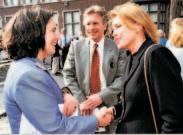

April 17 was a very special day for the School ofVeterinary Medicine!

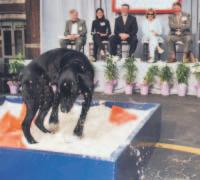
We broke ground for the new Teaching and Research Building—more accurately,had the ground broken for us by Bailey,a canine member ofthe Pennsylvania Task Force 1 Urban Search and Rescue Team.We honored Dr.Judith Rodin,CW’66,with the School’s Silver Bellwether Medal.And we launched a fundraising campaign.It was a busy day!
We welcomed a number offriends and alumni who attended “Classes without Quizzes”in the afternoon and who joined us for the groundbreaking and the festive evening.Here the prime attraction was Nobel Laureate Dr.James Watson,co-discoverer of the helix structure ofDNA,who gave a very lively speech.Following Dr.Watson,Campaign Chair Laurie Landeau,V’84,WG’84, announced that the School just entered the public phase ofa $100-million fundraising campaign.A video highlighting the needs for this campaign was shown.
“We started this campaign four years ago with an $18-million grant from the Commonwealth, and that was a wonderful start for us....”
Dean Alan M.Kelly“Many of the resources for this new building have come from private contributions,private giving.The Veterinary School has the most wonderfully generous and loyal group offriends that any school could wish to have.”
Dean Kelly“Really,the Commonwealth has been a partner,a believer,a supporter from day one in this project.It provided the stimulus to our fundraising and,of course,ifyou think about the University ofPennsylvania and all of its progress,nowhere is Penn more of Pennsylvania than it is at the School of Veterinary Medicine.”
Christine Connelly
“Soon we will have a building that will allow this school,if you’ll pardon the metaphor, to break new ground,not only in veterinary medicine,but in areas ofmedicine that have many important implications for human health.”
University President Judith RodinMelissa Sanchez,Russell Redding,Judith Rodin,and Christine Connelly,with Bailey.
“…[I]t has been 40 years since a major building at the Vet School has been dedicated exclusively to teaching and research,and the need and the anticipation could not be any greater.”
Christine Connelly,chair,Board of Overseers
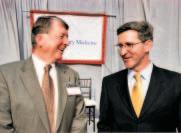

“Reaching our goals,obviously,will not be easy even though it sounds like,wow, we have $78 million and we don’t have that many more to go,but many friends and alumni have already stretched to get us this far.So now we are really going to have to invite others to participate and to come and be invested in our vision.We are going to spend the next 26 months engaged in a significant outreach effort.”
Laurie Landeau,V’84,WG’84,Campaign Chair
“The $18 million that has been committed to the project we view as sort ofyeast; it’s helped to raise the rest ofthe money,the rest ofthe critical dollars to make this project work.”
Russell Redding,Executive Deputy Secretary of Agriculture,Commonwealth ofPennsylvania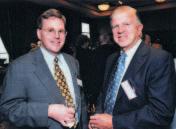
“Sometimes I still go and sit in Room A,especially after a tough day in clinics,and every time I sit there I can feel the presence ofthose who have gone before me and I remember why I am in this profession to begin with.”
Karen O’Connor,V’04,Class President“We believe that the investment in the School ofVeterinary Medicine has both immediate and long-term benefits for the Commonwealth as one ofthe largest single contributors to the Teaching and Research Building.We are confident that this new facility will ensure that Pennsylvania has the best possible space to educate men and women who will care for the state’s animals, both large and small,well into the 21st century.”
 Russell Redding
Russell Redding

“When the shadow ofthe new Teaching and Research Building falls upon the Old Quadrangle Building,it will not be a shroud,but an arm uniting the past and the future of veterinary medicine.”
Karen O’Connor,V’04
“One ofmy main motivations to attend the University ofPennsylvania was the opportunity to be at a veterinary school which recognized both the importance in research in veterinary medicine,and also the critical role that veterinarians have in research.”
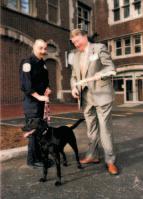 Melissa Sanchez,V.M.D./Ph.D.student
Melissa Sanchez,V.M.D./Ph.D.student
“As our world evolves,veterinarians are faced with new challenges which transcend traditional veterinary medicine.Some ofthese challenges are in public health,bioterrorism,and developing new treatments,not only for animals,but for humans.”
Melissa SanchezView the Groundbreaking Ceremony and the campaign video,as well as transcripts ofthe speeches ofour distinguished guests,on our website at <www.vet.upenn.edu>.
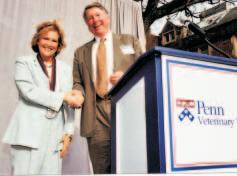
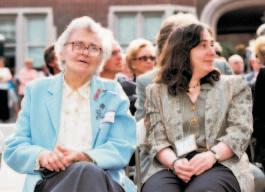
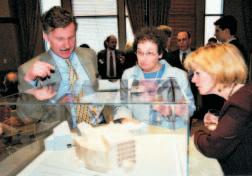
“I learned a little bit about how architects and engineers speak. Our building is not a complete box,nor is it an imperfect cube, rather it’s a platonic solid with a vibrant façade.”
Richard O.Davies,chair,Building Committee
“We quickly came to realize that the School’s needs were great and any extraordinary fundraising effort was going to be one that was comprehensive, because it wasn’t just the building; we have teaching needs,we have research needs,we have other infrastructure needs,we have programmatic needs, we have an enormous need to ameliorate the enormous debt burden of our students.”
Dr.Landeau“We all know that dogs resemble us in many sorts ofways.So in studying dogs we’ll be studying ourselves.”
Watson
“I got started because,basically,ifyou could finally understand human disease,human beings, you might as well see the instruction book,and, as you all know,the project succeeded.”
Dr.Watson
“The School ofVeterinary Medicine is an integral and unique part ofthe health science fabric ofthe University ofPennsylvania.”
Dr.Rodin
“Most likely a few ofyou realize just how long we have been working toward this night,the kickoffofour capital campaign.We have worked on this through three University presidents and two Veterinary School deans.…Over time,the goals and the focus have changed,but the need for the capital campaign has not.”
Dr.LandeauDuring the groundbreaking ceremonies for the new Teaching and Research Building, Dean Alan M.Kelly presented the Silver Bellwether Medal to University President Judith Rodin.“…This is actually a bittersweet moment for us because, President Rodin,this is the last time that you will be here at an official event at the VeterinarySchool while you are President ofthe University and we wanted to mark that.”
The medal citation follows:
RESOLVED,Judith Rodin,as President you have expanded the scope ofpossibilities for the University ofPennsylvania’s students,staff,and faculty,while simultaneously including the citizens in the surrounding West Philadelphia area.The School of Veterinary Medicine congratulates you on your unique visualization and leadership that has enhanced the University in higher education,research,and client care; Penn is now at the apex ofthe Ivys.As never before,you have brought passion and verve to Penn.
RESOLVED,Judith Rodin,through your insight and support the Commonwealth ofPennsylvania appropriation for the School has more than trebled.This was a direct result ofyour fair-mindedness.Equally important,was your presence at appropriation hearings in Harrisburg whereupon you reinforced the School’s request for state funds.Your presentations at these hearings were distinctively scintillating and you greatly impressed the Assembly with your intellect and eloquence.You gathered immense respect among the Commonwealth’s General Assembly.In so doing,time after time,you paved the way for approval of the School’s funding appeal.
RESOLVED,Judith Rodin,your effective lobbying ofthe governor for “brick and mortar”funds led to this glorious day of groundbreaking for a new Teaching and Research Building; we are enormously grateful.It is safe to say that we would not be here today without your vigorous support in Harrisburg.

RESOLVED,Judith Rodin,for all ofyour magnanimous contributions to the University ofPennsylvania we are immeasurably thankful.We,however,shall fondly remember the Rodin Years as a time ofspecial friendship to the School of Veterinary Medicine.

As a token ofour immense appreciation and esteem,I am pleased to award you the School’s highest honor,the Silver Bellwether Medal.
University ofPennsylvania School ofVeterinary Medicine
April 17,2004
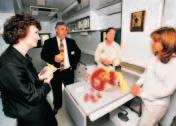
Equine surgeon Patricia M.Hogan,V’92, regularly scans the Daily Racing Form,tracking the progress ofher recuperated “alumni”to see ifher medical care has made a difference.
But there’s one former patient that she’d need blinders and earplugs—and a cave in Nepal—to lose tabs on.
It’s Smarty Jones.First unbeaten Kentucky Derby and Preakness Stakes victor since Seattle Slew in 1977. And,recalls Hogan, who treated the threeyear-old stallion for a potentially life-threatening head injury last summer,a “playful and fun-loving”horse.

Hogan and Smarty collided paths last July 28,following a frenzied call from a track veterinarian at Philadelphia Park reporting an accident in the starting gate. A horse had reared up,smashing his skull against an iron bar and,reportedly,momentarily lost consciousness.“I’m sending you a mess,” Hogan remembers the veterinarian saying. And a mess he was:“The left side ofhis face was blown up like a balloon,”she says.Two inches ofprolapsed conjunctiva spilled out of his left orbit.His nostrils wept blood.
Monsterlike,Smarty trotted into the barn at New Jersey Equine Clinic,in Clarksburg,N.J., “as ifnothing ever happened,”Hogan remembers.“He was cool as a cucumber.”
Despite Smarty’s take-it-in-stride demeanor, Hogan worried.Although she’d handled a few ofthese rare starting-gate injuries in the past, she had never seen one ofthis magnitude.Was the horse neurologically intact? Was his vision impaired? Were his sinuses damaged enough to compromise air flow and thus athletic performance?
Upon admission,Hogan stopped the hemorrhage and performed a neurologic exam, which was normal.She ultrasounded the left eye and found it to be intact,but could not assess Smarty’s vision until about a week later, when the extraocular swelling had subsided enough to perform a thorough ophthalmic exam.And she x-rayed his skull,which contained multiple pulverized fractures around his
left eye,left zygomatic arch,and sinuses. Because his skull had virtually “exploded”in pieces below his skin,there was no way to surgically fit the fragments back together.
Fortunately,Hogan says,“Everything was still sitting in place.”So she firmly padded Smarty’s skull with three inches ofbandages, dubbed him “Quasimodo,”and crossed her fingers.After a couple weeks ofbroad-spectrum (systemic and intraocular) antibiotics and anti-inflammatories,and stall rest, she discharged her good-natured patient.
Throughout the ordeal,Hogan was impressed with owners Roy and Pat Chapman,a scrappy pair who’d plied unexceptional bloodlines to produce their star stallion on their former 100-acre Someday Farm in Chester County,Pa.

Smarty’s trainer,John Servis,who had only schooled the horse for three weeks when the injury occurred,finally broached the subject of racing with Hogan.“He told me,‘You’ve got to do something,because this horse can run.’”
“…this horse can run”: all-too-familiar words to Hogan,whose practice takes in some 3,000 cases annually—mostly racehorses (60% Thoroughbreds,40% Standardbreds)—drawing from more than a dozen tracks in New Jersey,New York,Pennsylvania,Delaware,Maryland, and Virginia.
But coming from Servis, who stood out amongst the other trainers for his modest reserve,these words resonated with Hogan.She’d placed herselfat the track from an early age,and had developed an instinct for all things horse.
“From the moment I can remember,I loved horses,”she says.“I drew them.I cut their pictures out ofmagazines….”
Growing up with six siblings in urban Edison,N.J.,the small harness-racing track a few miles from home became her refuge.From the age often,she was cleaning stalls and walking horses.By 15,she was driving them.Then came summers assisting the veterinarian at Hanover Shoe Farms,the nation’s foremost Standardbred breeding operation,in Hanover,Pa.
At the University ofDelaware,Hogan majored in animal science,but her plans for a career in veterinary medicine were temporarily derailed when her application to Penn Veterinary Medicine was denied.Undaunted,Hogan begged for a job at New Bolton Center,where she cleaned stalls and raised eyebrows as the only woman operating the forklift that removed carcasses.
The powers-that-be soon took notice.Dr. Thomas J.Divers gave her a job working with his bovine leukemia herd.Client and School benefactor Anne F.Thorington offered her free accommodations on her farm in exchange for foaling out her mares.And Charles W.Raker, C’41 V’42,promised to help her gain acceptance into the School.
She enrolled the following year and spent most ofher free time—and then some— around horses.“Whenever possible,I would cut my small-animal classes so I could spend my afternoons at New Bolton, because I just had to see a horse.”
In her third and fourth years,she worked in largeanimal surgeon Dr.Dean W.Richardson’s lab and raised her own professional standards.“At New Bolton Center,they demanded excellence.And you wanted to do well because you respected the people there,” she says.
Following an internship at the distinguished Rood & Riddle Equine Hospital—in Kentucky bluegrass country—and a three-year large animal surgery residency at Texas A&M University College ofVeterinary Medicine,Hogan headed back to New Jersey to become an associate at New Jersey Equine Clin-
Only one event can lead my report of happenings since my last message:the April groundbreaking ofthe School’s new Teaching and Research Building.I wish every graduate could have attended this memorable event, which took place on a beautiful spring day in the Old Quadrangle Courtyard—an area where all ofus have walked, talked,laughed, and perhaps cried.The new building will be the first for the School in Philadelphia in 25 years,the fifth in 120 years—and as such,its place in history is assured.
Excellence in teaching and research—that is where we came from,that is who we are.Without it,we risk losing our identity as top-notch VMDs.On that historic day in April,University President Judith Rodin,CW’66,recognized “[the School’s] wonderful alumni,who do so much in the Commonwealth ofPennsylvania,” and thanked us “for keeping Penn’s name bright.”In addition,Russell Redding,the Executive Deputy Secretary ofthe Pennsylvania Department ofAgriculture,reaffirmed the School’s critical role in Pennsylvania agriculture,the state’s largest industry.
The 2004 Alumni Liaison Committee met at New Bolton Center in March.This year,as part ofits review,the Committee focused on the Department ofClinical Studies—New Bolton Center.You will read a report oftheir findings in the next issue of Bellwether.Serving on the Committee is a great opportunity to interact with the School’s administration,faculty,and students,and I encourage every alumnus to consider serving on the Committee.Ifyou are interested in serving in the future,please contact Marilyn B.Weber,V’75,Alumni Liaison Committee Chairperson,at (732) 449-9224 or via email at seagirtah@msn.com.
This past year,the VMAS Executive Board’s committees accomplished several important projects.The OffCampus Involvement Committee,chaired by Elizabeth M.McMurtrie, V’88,helped recruit alumni to volunteer at the
School’s booth at the Pennsylvania Farm Show. Thank you to everyone who volunteered their time this year,and we hope more will participate next year.
The On Campus Involvement Committee, chaired by Jack Bregman,V’66,is focusing its energies on Alumni Weekend 2004,Saturday, October 2,at New Bolton Center.The new autumn date offers many opportunities for enjoyment and will reduce the conflicts for alumni with the many weddings and graduations in May.In addition to the VMAS Annual Meeting,alumni picnic,seminars on Penn undergraduate admissions and veterinary school admissions,we also hope to offer hayrides with pumpkin picking,children’s music,and storytelling during the day.In the evening,the alumni dinner will be held at the Stone Barn,a large,rustic,and beautiful facility with outstanding food,only 15 minutes from New Bolton Center.(An alumni golfouting may be held on Sunday,October 3.)
As the School’s FY’04 Commonwealth
appropriation was reduced by five percent or nearly $1.9 million from its FY’03 appropriation and as the FY’05 appropriation is not expected to include an increase for inflation,the generosity ofour alumni and friends is more important than ever.These cuts have an adverse effect on the School in the form ofhigher tuition,a lower cap on faculty raises compared to the rest ofthe University,and more deferred maintenance.
As a result,opportunities like the Landeau Challenge must not be missed. Laurie J. Landeau,V’84 WG’84,will give $150,000 to the School ifalumni contribute $150,000 in new and increased gifts to the Veterinary Student Scholarship Fund before June 30,the end of Penn’s fiscal year.As ofApril 30,the contributions ofmore than 600 alumni have totaled $135,000 toward meeting the Landeau Challenge.Ifyou have already made your gift, you have my heartfelt thanks.Ifnot,please be as generous as you can to help us meet the Landeau Challenge before June 30.
continued from page 19
ic,among the East Coast’s most prominent,and busiest,equine hospitals catering to racehorses.
At the 140-acre,44-stall hospital,which is owned by American Association ofEquine Practitioners (AAEP) president-elect Scott Palmer,V’76,Hogan,39,performs four or five surgeries daily and sees the occasional noncritical medicine case.
And yes,Hogan—who is married to successful Standardbred trainer Eddie Lohmeyer and breeds her own Standardbreds—follows the ponies,particularly the ones who once had lain before her in the O.R.Her clients include a halfdozen or so trainers involved in the last Kentucky Derby.
And then there’s that standout patient who comes along once in a career:Smarty Jones, who graduated from Hogan’s care last August to make his debut as a two-year-old in November.Although five months late to the starting gate as a result ofboth tragedy (his previous trainer was murdered) and injury,Smarty ran undefeated in his first eight races until he fell one victory short,by one length in the Belmont Stakes,ofbeing the first Triple Crown winner since 1978.
“I said to the staff,‘Hey you guys,remember
Quasimodo?!’”Hogan,who covers New Jersey horse races as part ofthe AAEP’s “On Call” program,which provides veterinary information to the broadcast and print media during all live-broadcast racing events,started a bulletin board at the clinic to post newspaper clippings from Smarty’s races.
Following the Derby win,word got out that she had treated Smarty’s head injury,and Hogan’s clinic soon became inundated by media calls and film crews.And Hogan herself became rushed with praise.Smarty’s owners, the Chapmans,“thanked me a million times.” Her boss,Scott Palmer,also had kind words: “This horse had all the natural ability to be a champion,but might not have had the opportunity ifthis injury were not treated and rehabbed so well.”
Hogan modestly spreads the credit amongst the team,including Smarty.“I’m just so proud ofhim and my staff,and also ofour client John Servis for making all the right choices,”she gushes.“This is the pinnacle for someone who works with Thoroughbred racehorses.”
Editor’s Note: Smarty Jones’s regular veterinarian is Roger B.Clymans,V’71,who is based at Philadelphia Park.
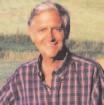
It was a pivotal moment for Bethany J. Grohs,V’98,one she remembers well.As a career-planning exercise in a third-year course at Penn Veterinary Medicine,she and her classmates were asked to fast-forward five years beyond graduation:Where did they hope to be professionally?
“I wrote down that I wanted to be part ofa team that does multidisciplinary problem-solving on environmental issues internationally. But,”she soberly recalls,“I figured that a job like this didn’t really exist for a veterinarian.”
Happily,Grohs proved herselfwrong.As a veterinary medical officer with the U.S. Environmental Protection Agency’s Environmental Response Team in Edison,N.J.,she manages the animal side ofthe environmental contamination equation.
Since joining EPA in 1999,Grohs,33,has collaborated with the National Marine Fisheries Service to collect environmental health samples from bottlenose dolphins,investigated suspected cases ofbovine fluorosis associated with industrial emissions,and assisted with the footand-mouth disease outbreak in the U.K. Grohs,whose job post-9/11 includes collaborating with the U.S.Department ofHomeland Security on counterterrorism issues,also designed a decontamination system for the World Trade Center search-and-rescue dogs, and investigated related toxin exposures.(She lectured at Penn Veterinary Medicine on Disasters,Disease,and Defense in April.) And she helped coordinate response efforts to the anthrax crisis at Capitol Hill.
Her field work is balanced in equal parts with policymaking,a combination,she says, that offers unique advantages:“In the office, you write policy that makes practical sense. And then when you’re in the field,you can understand how those decisions have been made.”
To bolster this decision-making process, Grohs,who takes call one week every other month for national environmental emergencies,has initiated contact with EPA’s 11 other veterinarians—all researchers—to weave the results oftheir scientific investigations into policy.
Growing up on a farm in coastal Maine, Grohs spent her youth hiking,camping,riding horses,and developing an enduring apprecia-
tion for animals and the outdoors.During her junior year at Colby College,where she studied biology and chemistry,Grohs spent a semester assessing wildlife parks in Africa.There,she grasped the impact ofpark management on the hardiness ofthe animal residents.
Her nagging desire to become a veterinarian
and know you’re getting a little bit done at a time.”
Grohs,a member ofthe American Veterinary Medical Association’s Committee for Environmental Issues,notes a striking similarity between clinical practice and ecologic risk assessment.She likens the latter to a ten-minute exam on a pet—“but on a much bigger scale”—from history-taking to diagnostics to treatment plan.
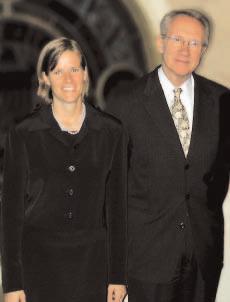
And just as in clinical medicine, she notes,her regulatory role requires her to be a good communicator.“You need to be able to explain scientific concepts well. But,”she adds,“you also need to be a good listener and not just a font ofknowledge.”
As an EPA veterinary medical officer,Grohs must communicate in a broad range ofsituations that vary considerably in formality, from spontaneous exchanges with farmers in barns to planned briefings before the U.S.Senate.
was tempered by the discouraging advice ofher college advisers,who reminded her ofthe difficulty ofbeing accepted into veterinary school. So following graduation,Grohs headed back into the outdoors,working as a wrangler at an Arabian horse ranch in Wyoming.This led to a job at a local veterinary practice and a rekindling ofher desire to pursue veterinary medicine.
After graduating from veterinary school,she headed out to Montana to work in mixed-animal practice.She enjoyed her year in clinical practice,particularly the opportunity to readily quantify the fruits ofher daily efforts.“At the end ofthe day,for instance,I could go home knowing I spayed three animals.”
In her subsequent government work,the pursuit ofresults requires considerably more patience.“The way you deal with the red tape,” she explains,“is to keep a long-term perspective
Whether she is meeting with members ofCongress,producers or industrial workers,Grohs observes that introducing herselfas a “veterinarian”rather than as an “environmental regulator”or even a “scientist”opens the door to more positive interactions in her work.“People stand up all the time and say,‘I’m a scientist.’But when I say,‘I’m a veterinarian,’there is a much different sense— that you’re someone who really cares.”
Indeed,Grohs cares immensely about the fitness ofour fauna and flora.While many governmental resources are directly devoted to reducing human health risk,she explains,“I focus on the environmental health risk because ifyou have a healthy ecosystem,the people will be fine.”
Banfield,the Pet Hospital,has announced the recent hiring ofthree alumni at their veterinary hospitals: Gregory L. Cusanno,V’70,and Carrie A.Hutchinson, V’01,practicing in Warminster,Pa.;and Corinne Majeska,V’03,practicing in Cherry Hill,N.J.
Anthony M.Stefanski ofCrowley,La.,writes:“I read,with interest,the [Fall 2003] Bellwether.… I realize now,how much my education at the University ofPennsylvania [has] meant to me.… Enjoy news from and about my alma mater.”
Arthur Richards,Jr. has recently published his autobiography, Tale Waggings: Recollections ofa Rural Veterinarian,and donated a copy to be placed in the School’s library.Dr.Richards tells how he established his practice in rural western Pennsylvania and was thrown into unexpected situations,remarking,“They never told me in veterinary school it would be like this.”Using humor,he describes many tales from his 50 years oftreating large and small animals.To read an excerpt or to order the book,visit <www.buybooksontheweb.com/description.asp? ISBN=0-7414-1128-8>.
Leigh A.Marsh,a collector ofTurkmen main carpets,which are among the finest and most intriguing carpets in the world,donated several from his collection for display in a recent exhibition at Penn’s Arthur Ross Gallery.Rarely exhibited together due to their large size,“Antique Rugs ofthe Turkmen Tribes”brought together several Turkmen main carpets,as well as other trappings and smaller utilitarian pieces that date from 1800–1875.
George E.Eyster,a professor in the Department ofSmall Animal Clinical Sciences at Michigan State University College ofVeterinary Medicine,was honored with the Distinguished Veterinary Faculty Award during the College’s Commencement ceremo-
The 2004 Slate ofOfficers ofthe Pennsylvania Veterinary Medical Association consists solely ofPenn alumni.The officers are:
Michael R.Moyer,V’90,President
Timothy J.Ireland,V’90,President-Elect
David R.Wolfgang,V’82,Vice-President
James R.Rummel,V’79,SecretaryTreasurer
Gregory W.Godon,V’73,AVMA Delegate
Congratulations and good luck to the 2004 officers!
ny in May 2004.Dr.Eyster was recognized for his pioneering achievements in veterinary cardiology,for providing a model ofexcellence to veterinary students,and for his ongoing commitment to the wellbeing ofthe College.
H.Michael Maetz has recently retired as professor ofepidemiology at the University ofAlabama at Birmingham School ofPublic Health.
1968
H.Wesley Towers,Jr.,the state veterinarian of Delaware,was appointed by Delaware Governor Ruth Ann Minner in 2003 to a six-year term on the University ofDelaware Board ofTrustees.He is a 1964 graduate ofthe University.He serves on numerous national committees including the U.S.Secretary ofAgriculture’s Advisory Committee on Foreign Animal and Poultry Diseases and the American Veterinary Medical Association Committee on Disaster and Emergency Issues.
Ralph E.Werner,Jr. has recently been promoted to associate professor ofbiology at The Richard Stockton College ofNew Jersey.He also serves as the Biology Program coordinator and the health professions adviser.
Fred W.Quimby,director ofthe Lab Animal Research Center at The Rockefeller University in New York City,was quoted in the January 15,2004 edition of The Wall Street Journal,in an article about six medical schools and hospitals in New York City that are planning to build a shared $15-million facility to house 25,000 research mice.According to Dr. Quimby,“As fast as we can increase the density of mouse housing,it gets filled.”
Alan G.Schonfeld reopened Gwynedd Veterinary Hospital in Upper Gwynedd,Pa.,in a newly constructed facility on December 31,2003.A fire destroyed the former building on January 10,2003. The hospital remained open in temporary quarters during construction ofthe new facility.
Arthur V.Tennyson has retired as the assistant executive vice president ofthe American Veterinary Medical Association.He had served the AVMA in a variety ofpositions since 1977.
Scott E.Palmer visited Penn Veterinary Medicine and spoke to students in April 2004 as part ofthe Dean’s Alumni Career Speaker Series.Dr.Palmer is
president and a staffsurgeon at the New Jersey Equine Clinic in Clarksburg,N.J.,and is presidentelect ofthe American Association ofEquine Practitioners.
During the Pennsylvania Veterinary Medical Association’s 121st Annual Scientific Meeting in August 2003, James R.Rummel was honored with the Veterinarian ofthe Year Award in recognition of his outstanding service,enthusiastic leadership,and tireless dedication to the PVMA and the veterinary profession.Dr.Rummel is a partner and hospital administrator ofCamboro Veterinary Hospital,a small-animal practice,in Edinboro,Pa.
1980
Diane Ruth Eigner was interviewed in an article about how to pick a new kitten in the February 18, 2004 edition of The Wall Street Journal.Dr.Eigner is a past president ofthe American Association ofFeline Practitioners,and practices at The Cat Doctor in Center City Philadelphia.
Fern Tablin is a professor at the University of California,Davis,School ofVeterinary Medicine.She has a special interest in cell biology and has studied various aspects ofplatelets for the past 20 years.Dr. Tablin is a principal investigator in the School’s Center for Biostabilization,which seeks methods to stabilize blood cells in a dry state for long-term storage and ultimately therapeutic use.
1981
Jeffrey T.Berk,a partner at Ocala Equine Hospital in Ocala,Fla.,is a new director-at-large on the American Association ofEquine Practitioners board ofdirectors.
H.Mark Saunders,immediate past president of the American College ofVeterinary Radiology, received a plaque ofappreciation for his service to the College at its annual meeting in December 2003.
1982
Peter B.Reiner is ChiefExecutive Officer of Active Pass Pharmaceuticals,a biotechnology firm focused on genomic-based drug discovery,which is based in Vancouver,British Columbia.Prior to founding Active Pass in 1997,Dr.Reiner was the Louise Brown Professor ofNeuroscience at the University ofBritish Columbia.
1983
Susan G.Emeigh Hart is a new diplomate ofthe American College ofVeterinary Pathologists and is certified as a veterinary clinical pathologist.
1984
Dennis E.Burkett is President-Elect ofthe Veterinary Emergency and Critical Care Society, which works to raise the level ofpatient care for seriously ill or injured animals through quality education and communication programs.
1985
Elizabeth S.Sinnigen,a practitioner at VCA Rotherwood Animal Hospital in Newton,Mass.,was honored in May 2004 with the Massachusetts Veterinary Medical Association’s 2003 Distinguished Service Award.The award,the most prestigious award that the MVMA confers,is given for accomplishments in the MVMA and in veterinary medicine,and for outstanding contributions to the service ofhumankind.Dr.Sinnigen,who has been active in organized veterinary medicine in Massachusetts,has advocated for the creation ofan appendix to the Massachusetts Comprehensive Emergency Management Plan,which articulates a protocol for the treatments ofdomestic and wild animals in a disaster or emergency.
William H.Yerkes IV became a member ofthe Royal College ofVeterinary Surgeons,the regulatory body for veterinary surgeons in the United Kingdom, in May 2003.
Living in Wauchope,New South Wales,Australia, Angela E.Frimberger and her husband,Dr.Tony Moore,have opened Veterinary Oncology Consultants,a fax- and Internet-based consulting business to help veterinarians care for pets with cancer.Visit their website at <www.vetoncologyconsults.com>.
Celeste C.Kunz spoke at the International Conference ofRacing Analysts and Veterinarians held in March 2004 in Dubai,United Arab Emirates.Dr. Kunz lectured on the management ofcatastrophic racing injuries.
Sean D.Smarick is a new diplomate ofthe American College ofVeterinary Emergency and Critical Care.He completed a residency in Small Animal Emergency and Critical Care at the University ofCalifornia,Davis,School ofVeterinary Medicine.Dr. Smarick is director ofAllegheny Veterinary Emergency Associates,P.C.,in Pittsburgh,His wife,Lisa, gave birth to their first child,a daughter,Brooke Bea, on December 20,2003.
Lisa A.Murphy is a new Area Emergency Coordi-
nator for Veterinary Services,a part ofthe U.S. Department ofAgriculture’s Animal and Plant Health Inspection Service.Based in Sutton,Mass.,Dr. Murphy is responsible for six New England states. Veterinary Services protects and improves the health, quality,and marketability ofthe nation’s animals, animal products,and veterinary biologics.
E.Scott Weber visited Penn Veterinary Medicine and spoke to students in May 2004 as part ofthe Dean’s Alumni Career Speaker Series.Dr.Weber is the head veterinarian at the New England Aquarium in Boston.
Mary Jane McNamee and her husband, Mark A. Kapolka,V’97,were profiled in Sunday Patriot-News ofHarrisburg,Pa.,on November 9,2003.They were planning to open a new “progressive and proactive” practice together in Cornwall,Pa.,by May 2004. According to Dr.McNamee,“Most people think of their pets as family members.And that affects their health care choices.We want to be advocates for our patients,but not bully our clients into doing things they don’t want to.”They have three children,twin one-year-olds and a three-year-old.
Matthew S.Johnston has become board-certified in avian practice by the American Board of Veterinary Practitioners.
Patrick A.Mahaney visited Penn Veterinary Medicine and spoke to students in March 2004 as part of the Dean’s Alumni Career Speaker Series.Dr. Mahaney practices at Metropolitan Emergency Animal Clinic in Rockville,Md.,and is a Baptiste Power Vinyasa instructor at Down Dog Yoga in Washington, D.C.
Alisa L.Newton is a new diplomate ofthe American College ofVeterinary Pathologists and is certified as a veterinary anatomic pathologist.
Paul J.McGough,a veterinarian at Metropolitan Veterinary Associates in Valley Forge,was interviewed in the April 6,2004,edition of The Philadelphia Inquirer,in an article about the danger ofEaster lilies to cats.Dr.McGough sent letters to area businesses selling lilies asking them to post warning signs about the plant’s toxicity,which causes kidney failure in cats.
Daniel L.Schar has been selected as a Luce Scholar for 2004–05.Funded by the Henry Luce
Foundation,the Luce Scholars Program provides stipends and internships annually for 15 young Americans to live and work in Asia for a year.The program’s purpose is to increase awareness ofAsia among future leaders in American society.
Jessica A.Chavkin,an intern at the Animal Medical Center in New York City,was one ofthe veterinarians featured in “Pet E.R.,”an article about the AMC,which appeared in the January 19,2004,issue of People magazine.
Karena Joung,an intern in the Department of Small Animal Clinical Sciences at Michigan State University College ofVeterinary Medicine,was honored in April 2004 with the SCAVMA Intern Award. The award was given in recognition ofher outstanding performance in the clinical training and teaching ofstudents.
2003
Vicki Campbell,assistant professor ofemergency and critical care medicine at Colorado State University College ofVeterinary Medicine,is a new diplomate ofthe American College ofVeterinary Emergency and Critical Care.
Justine A.Lee,assistant clinical professor of emergency services at the University ofMinnesota College ofVeterinary Medicine,is a new diplomate of the American College ofVeterinary Emergency and Critical Care.
For hotel reservations and tourist information,visit http://alumni.vet.upenn.edu/alumniweekend2004.html
1998
Derek S.Boen,a son,Sean Christopher,on July 8, 2003.
1999
Jennifer A.Morris,a son,Calvin Robert,on January 25,2003.
Deaths
1936
Robert R.Crelin on December 28,2002.
1937
Russell S.Edmonds on May 26,2004. Leo R.McKinney on March 24,2003.
1940
Benjamin L.Walbert,Jr. on March 18,2004.
1941
Thomas W.Brown on September 20,2003.
1943
Jacob Finkelstein on December 3,2003.
Remembrance of Steven L.Schwartz,V’80
Steven L.Schwartz,V’80,died suddenly ofa heart attack on December 5,2003,while visiting his hometown ofHavertown,Pa.In 1981,Dr. Schwartz joined the Metropolitan Emergency Animal Clinic (MEAC) in Rockville,Md.,and managed the country’s second-oldest primary animal emergency clinic until his death.His legacy is the hundreds ofveterinarians whom he mentored at MEAC during their emergency medicine clinical rotations as veterinary students.
According to Victoria Hampshire,V’88,an associate veterinarian at MEAC,Dr.Schwartz was known for his easy-going attitude and his tremendous sense ofhumor.“Most people don’t think ofemergency veterinary medicine as fun.It is upsetting for pets,owners,and employees.He was a lovable curmudgeon in times ofchaos,and this special kind ofhumor and generosity when mixed with his professionalism enabled those around him to be immediately at ease during unnerving events.People just kept on working there,and the wall is covered with letters from grateful pet owners.”
Dr.Schwartz was a member ofthe Maryland Veterinary Medical Association,the American Veterinary Medical Association,and the Veterinary Emergency & Critical Care Society.He enjoyed sailing,traveling,and the theater,and volunteered as a mentor to students.
1945
Scott H.Heffner on November 20,2003.
1947
John R.Church on February 28,2004. James W.Goris on November 21,2003. Dorian Lugo on February 8,2004.
1948
William Deeds Donovan on March 8,2004.
1949
G.Robert Muller on February 5,2004.
1950
George L.Stolte on May 14,2003.
1959
John C.W.Bauersfeld on September 18,2001.
To find a former classmate and to sign up for a permanent email forwarding service: Join the University ofPennsylvania Alumni OnLine Community for free at <www.alumni connections.com/olc/pub/UPN>.After you register,you can search the On-Line Directory,which is a great resource for personal and professional networking and an easy way to keep up-to-date on fellow alumni.You can also sign up for a permanent email forwarding service,which will forward messages received at your permanent Penn address to the email address ofyour choice.
To update your alumni record: You can update your record via the University of Pennsylvania Alumni On-Line Community OnLine Directory.You may also contact Elizabeth McNamara at (215) 746-7461 or via email at <emcnamar@vet.upenn.edu>.
To make a gift or for information to support Penn Veterinary Medicine: Make a gift with your credit card through a secure online transaction at <www.upenn.edu/gifts>.For information on supporting the School,visit the Alumni & Friends website at <alumni.vet.upenn. edu> or contact Joshua E.Liss at (215) 898-1481 or via email at <lissj@vet.upenn.edu>.
To request a transcript,certification of graduation, or replacement diploma: For information on requesting a transcript,visit the Office ofthe University Registrar’s website at <www.upenn.edu/registrar/transcripts/ transcripts.html> or call (215) 898-7511.For information on requesting a certification ofgraduation,which does not require a transcript,contact the School’s Office ofStudent & Curricular Affairs at (215) 898-3525 or via email at <studentaffairs@vet.upenn.edu>.For information on ordering a replacement diploma,visit the Office of the Secretary’s website at <www.upenn.edu/ secretary/diplomas/#replace>.
To post/search employment opportunities for veterinarians: Visit the School’s Veterinary Employment Database at <www.vet.upenn.edu/jobsearch>.
1960
Jordan M.Miller on October 18,2003.
Marlyn Ernst Prier on May 31,2003.
1965
Andrew H.Kraft on April 15,2004.
1967
John W.Knochel on February 4,2004.
1972
Mary A.Leisner on August 26,2003.
1980
Steven L.Schwartz on December 5,2003.
2001
Robert W.Richardson on January 14,2004.
To purchase veterinary,medical,and alllied health textbooks from leading publishers: Visit the Penn Vet Bookstore at <www.vet.upenn. edu/studentaffairs/bookstore>.A percentage of purchases is returned to the School in the form of scholarship funding to deserving veterinary students.
To obtain a Penn Alumni Card:
The Penn Alumni Card offers a myriad ofbenefits, including access to the Penn Libraries (does not include borrowing privileges or access to online resources) and discounts on admission to the Morris Arboretum,Class of1923 Ice Rink,and University ofPennsylvania Museum.The charge for the card,which is valid for 10 years,is only $20. For more information,visit <www.upenn.edu/ penncard/card/obtain_alumni.html>.
Alumni Relations and Annual Giving Staff
Joshua E.Liss
Director ofAlumni Relations and Annual Giving
(215) 898-1481
Fax (215) 573-3544
Email <lissj@vet.upenn.edu>
Elizabeth McNamara
Annual Giving Coordinator
(215) 746-7461
Fax (215) 573-3544
Email <emcnamar@vet.upenn.edu>
Please address any correspondence to: Office ofDevelopment and Alumni Relations
University ofPennsylvania School ofVeterinary Medicine 3800 Spruce Street Philadelphia,PA 19104-6047
Pennsylvania State University is the largest in the Commonwealth,and among the top ten in size nationwide.And that’s not even counting the animals.
The University’s 40,000 head ofstudents is amplified by some 1,000 cattle and sheep,nearly 100 American Quarter Horses and ponies, and dozens ofbreeding sows.There are aquaria brimming with native Pennsylvania fish and African cyclids.Thousands ofchickens and turkeys.Wildlife including raptors,turtles, snakes,and a herd ofwhite-tailed deer.And countless lab animals.
Overseeing them all is Jacob R.Werner, V’00,Penn State’s attending veterinarian for agricultural animals and wildlife.Werner is one offour veterinarians holding this vast menagerie ofproduction and bioscience animals together.
A land-grant university established in 1855 for agricultural use and engineering,Penn State relies heavily on its animals for teaching purposes.“Agriculture is the number-one industry
in Pennsylvania,”Werner explains,“so it’s important for students to learn animal husbandry and proper animal care.”
As a head veterinarian at Penn State,Werner divides his time between paperwork and fieldwork.On any given day,he might work up diarrhea in swine,diagnose foot problems in deer,do pregnancy checks on cows,or insert catheters in lab animals.
But Werner spends most ofhis time on regulatory issues,ensuring that procedures and husbandry protocols comply with regulations like the federal Animal Welfare Act and Public Health Service Policy on Humane Care and Use ofLaboratory Animals,and with guidelines issued by organizations like the American Veterinary Medical Association (AVMA) and the Association for Assessment and Accreditation ofLaboratory Animal Care International (AAALAC).
As a member ofPenn State’s Institutional Animal Care and Use Committee (IACUC), Werner also reviews experimental protocols that involve the use oflaboratory animals and

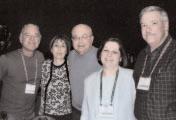
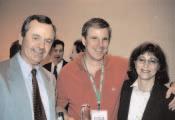
November 22,2003 inNew Orleans
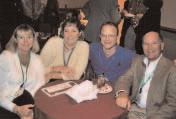
February 16,2004 in Las Vegas
helps enforce the University’s strict biosecurity measures.
While he admits to a dislike of“just busy paperwork issues,”he enjoys compliance work because it improves the care and well-being of the animals concerned.“Ifit’s an issue that can better animal welfare,”he says,“then we need to deal with it.”
For the poultry-processing plant on campus,Werner helped draw up a new euthanasia protocol incorporating electrical stunning prior to exsanguination.This added step,he says,has made the procedure more humane and in closer synchrony with AVMA guidelines.He’s also working with the dairy farm to incorporate the use oflocal anesthesia into calfdehorning.
No stranger to agriculture—or Penn State— Werner grew up in a rural town in northwestern Pennsylvania.There,he spent time helping out at his uncle’s dairy farm.And he paid close attention to the veterinarians treating his own horses,eventually working for one ofthem while a high school student and later while majoring in bioscience at Penn State.
Although he veered in the direction oflargeanimal medicine,Werner tried to maintain an open mind by choosing a mixed-animal concentration in veterinary school.Following a large-animal medicine and field service internship at the Virginia-Maryland Regional College ofVeterinary Medicine,he went to work for a mixed-animal practice.
When he arrived at Penn State last June, Werner,28,soon reaped the benefits ofhis strong clinical background,which,he says, helped him better understand the complex animal-use guidelines as well as the practical production matters.And it’s helped him face down some ofthe inherent challenges ofcompliance work.
“The hard part about regulatory issues is getting people like producers and basic scientists to understand why they are so important,” he says.
Werner,who serves as his veterinary school class agent,says his Penn experience helped him converse on the many different levels that his job demands.“I’m working with investigators, students,regulators….You need to be a good communicator in my job—understanding different processes,putting concepts together,and then explaining them.Penn always challenged me to do these things.”
With plans for the new Teaching and Research Building in the final stages,we want to update alumni and friends on the progress of the “Take a Seat”campaign,an initiative in naming a seat,to honor or remember a special person or a beloved pet.As ofMarch 31,2004, more than 185 ofthe 266 available classroom seats have been designated.The list that follows represents those who have completed or are in the process ofcompleting a booked pledge (pledge/gift form must have been submitted to the Development Office).
A classroom seat can be dedicated for a taxdeductible contribution of$3,000 that is payable over a five-year period.Ifyou have questions regarding the “Take a Seat”campaign, please contact Dori Myers,Major Gifts Officer, in the School’s Development Office at (215) 746-7438 or via email at dmyers@vet.upenn.edu.
Listings are shown as:
Person Making Pledge
Given in Honor of/in Memory of
Donald,V’61,and Sandy Abt
Given in Memory ofMark W.Allam,V’32
Dr.and Mrs.Gary C.Althouse
Given by G & C Althouse and Our Family…Present and Future
Richard C.,V’48,and Laverne Ainley
Given in Memory ofRobert A.Vanderhoof,V’45
Wilbur B.Amand,V’66
Given in Memory ofWilbur F.and Caroline M.Amand
Animal Rescue League ofPhiladelphia
Given in Honor ofthe School ofVeterinary Medicine’s Faculty and Students
Animal Rescue League ofPhiladelphia
Given in Honor ofDr.Josephine Deubler for Her Years ofService as Secretary
Anonymous
Given Anonymously in Memory ofJoan B.O’Brien’s,V’63,Love ofTeaching
Lillian R.Aronson,V.M.D.,D.A.C.V.S.
Given by Lillian R.Aronson,V’92
Dr.Michael Atchison
Given by Michael and Lakshmi Atchison with Love for Their Sons Alan and Steven
Kathleen and Richard Aucamp
Given by Kathleen and Richard Aucamp
Dr.Narayan G.Avadhani (two seats)
Inscription to Come
Joanna M.Bassert,V’89
Given by Dr.Joanna M.Bassert in Honor ofPenn’s Outstanding Veterinary Nurses
Jill Beech,V’72
Given by Jill Beech,V’72
Charles N.Bell,V’70
Given in Memory ofOur Cat Looch by Jeffrey,V’03,Charles, V’70,Barbara,Marc,and Jaclyn Bell
R.Avery Bennett,D.V.M.
Given in Memory ofRobert W.Richardson,V’01
Charles E.Benson,Ph.D.
Given in honor ofRichard A.McFeely,V’61
Charles E.Benson,Ph.D.
Given in Honor ofRobert J.Eckroade,D.V.M.,Ph.D.
Daniel B.Bleicher,V’53
Given by Carlo Bleicher and Daniel Bleicher,V’53 for Richard J. Bleicher,M.D.
Dr.Raymond C.Boston
Given in Honor ofthe Boston Sons: Sean,Marc,Paul,and James – Prospering Through Independence
Allan P.Bregman,D.V.M.
Given by Allan P.Bregman,D.V.M.,in Honor ofMy Parents, Jack,V’66,and Alicia Bregman
Eric M.Bregman,V’95
Given by Eric M.Bregman,V’95,in Honor ofMy Parents,,Jack, V’66,and Alicia
Jack,V’66,and Alicia Bregman
Given by Jack,V’66 and Alicia Bregman in Memory ofPatsy
Florence T.Brennan
Given in Honor ofBernard F.Brennan,V’46
M.Elaine Redding Brinster
Given by M.Elaine Redding Brinster,Faculty Wife
Lauren Brinster,V.M.D.,D.A.C.V.P.
Given by Lauren Brinster
Class of1990
Ralph L.Brinster,V.M.D.,Ph.D.
Given by Ralph L.Brinster
Class of1960
Dorothy Cimino Brown
Given in Loving Memory ofRobert and Dorothy Cimino
Dr.and Mrs.James W.Buchanan
In Memory ofDr.David H.Knight
Maron Calderwood Mays,V’68
Given in Honor ofWayne H.Riser,D.V.M.,by Maron B. Calderwood Mays,V’68
Mary Beth Callan,V’88
Given in Loving memory ofJohn G.Callan,Jr.by Mary Beth Callan,V’88
Barbara B.Cavanaugh
Given in Memory of“Susie”Bernoffand “Maggie”Cavanaugh by Barbara and David Cavanaugh
Lisa A.Cawley,V’92
Given by Lisa Cawley,V’92
Dr.Samuel K.Chacko
Given by Dr.and Mrs.Samuel K.Chacko
Jean Clair
Given in Honor ofMary Beth Callan,V’88,a Truly Superb and Caring Medicine Clinician,by Jean Clair,Referral Coordinator
Kevin P.Coogan,V’80
In Honor ofArthur P.Coogan,V52
Henry L.Croft,Jr.,V’78
In Honor ofMy Parents Henry,Sr.and Jimmie Croft,given by Henry Croft,Jr.,V’78
Dr.Richard O.Davies
Richard O.Davies,Department ofAnimal Biology
Sherrill Davison Yeakel,V’83
Inscription to Come
Patricia Day-Lollini,V’79
Given in Memory ofQuint and Meshach,by Patricia DayLollini,V’79
Dr.Adelaide Delluva
Given in Memory ofDwight McNair Scott,Ph.D.
David K.Detweiler,V’42
Inscription ofCome
Josephine Deubler,V’38
Given in Memory ofErnest C.Deubler,V’11
Trish A.diPietrae
Given by Trish diPietrae
Dr.William J.Donawick
Given by Dr.and Mrs.William Donawick,Faculty 1964-2002
Dr.Zhenyxia Dou
Inscription to Come
Robert C.Dreisbach,V’54
Given in Memory ofMy Mentors,William Boucher,V’40,and Arthur Bartenstagher,V’37
Roselyn J.Eisenberg,Ph.D.
Given by Roselyn J.Eisenberg in Memory ofRobert E.Davies, Teacher,Scholar,Friend
Dr.Jay P.Farrell
Given in Memory ofCarl E.Kirkpatrick,V.M.D.,Ph.D., Pathobiology
Neil R.Frank
Given in Loving Memory ofJanet Remetta,V’85 – Wife,Friend, and Humanitarian
Paul C.Gambardella,V’72
Given by Paul,V’72,and Susan Gambardella
Sheldon L.Gerstenfeld,V’68
Given by the Gerstenfeld Family – Tyler,Sheldon V’68,Traudi, Sidney,and Isabelle
Dr.Michael H.Goldschmidt
Given in Memory ofHeinz Goldschmidt and Sidney Straus
Anne M.Green
Given by Anne M.Green and Andrew H.Green in Honor ofOur Dogs
Elaine P.Hammel,V’60
Given in Honor ofMonica Reynolds,Ph.D.
Peter J.Hand,V’61
Given by Dr.and Mrs.Peter Hand in Memory ofJames and Edna Hand,Animal Biology
Mark E.Haskins,V’69
Given in Memory ofMitzi G.Haskins by Mark Haskins,V’69, Pathobiology
Park W.Haverstick,V’75
Inscription to Come
Dr.Paula S.Henthorn
Given in Memory ofWillis and Sue Henthorn
Peter H.Herman,V’69
Given in Honor ofthe Marriage ofMarie Gombar and Peter Herman,V’69,on October 18,2003
Steven Jay Heyman,V’87
Given by Steven J.Heyman,V’87
Dr.David Holt
Given in Honor ofLaurie Strine,V’90
Susan Jacobson,V’77
Given in Memory ofJohn L.Jacobson and Helen V.Plunkett
Dr.Janet Johnston
Given in Honor ofOur Loving Pets and to Their Compassionate Care
Mrs.Kathryn H.Johnston (two seats)
Given by Kathryn Johnston in Memory ofRobert N.Hartzell
Dr.Amy Kapatkin and Dr.Robert Poppenga
Given by Amy Kapatkin,Department ofClinical Studies,and Robert Poppenga,Department ofPathobiology
Susan L.Keiser
Given by Susan Lynne Keiser in Memory ofJessica
Malcolm J.Keiter
Given in Memory ofAlvin E.and Daphne L.Keiter by Their Sons
Alan M.Kelly
Given in Honor ofRobert R.Marshak,D.V.M.
Alan M.Kelly and Barry Stupine
Given in Memory ofSpeaker Matthew J.Ryan by Alan M.Kelly and Barry Stupine
Karen Tabak Kessler,V’96
Given in Loving Memory ofGeneva by the KesslerFamily
Seth A.Koch,V’65
Given in Honor ofLionel F.Rubin,V’58
Leonard Krawitz,V’39
Given by Leonard Krawitz,V’39
Laurie J.Landeau,V’84
In Memory ofGypsy 1981 – 1997,from Penn Vet to My Heart –Laurie J.Landeau,V’84
Andrea Landsberg,V’88
For Omo T.and Linea Alba by Richard and Andrea,V’88
Midge Leitch,V’73
Given in Memory ofThomas Leitch by Midge Leitch,V’73, Londonderry Equine Clinic
Joshua E.Liss
Given by Joshua E.Liss in Honor ofAll the Veterinarians Who Have Cared for His Pets
Meryl P.Littman,V’75
Given in Memory ofAlbert Podolsky by Drs.Gary and Meryl Littman,V’75
Lori S.Mann,V’95
Given in Loving Memory ofJayne B.Mann and Arden Salk Spencer
Patricia J.Mapps,V’96
Inscription to Come
Ashra Markowitz
Given by David,Norman,Minnie,and Ashra Markowitz
Dr.Robert R.Marshak
Given in Memory ofJohn E.Martin,V’42
Dr.Robert R.Marshak
Given in Honor ofMargo Post Marshak
Robert R.McDonald
Given in Memory ofMr.and Mrs.Thomas E.McDonald
Dr.and Mrs.Norbert R.McManus,V47
Given by Norbert R.McManus,V’47 and Mary M. McManus,R.N.
Dr.Kathryn E.Michel
Given in Honor ofJohn L.Mara,D.V.M.,by Kathryn E.Michel, D.V.M.,Department ofClinical Studies
Bonnie Miller
Given in Memory ofLucas,Our Smiling Golden,by Bonnie Miller and Harry Schwartz
Richard R.Miselis,V’73
Given by Richard R.Miselis,V’73,Animal Biology
E.Neil Moore,D.V.M.,Ph.D.,D.A.C.V.I.M.
Given by E.Neil Moore,D.V.M.,Ph.D.,D.A.C.V.I.M.,Professor, Physiology in Medicine,1962-2002
Dr.Daniel O.Morris
In Memory ofJohn J.Daniel,Grandfather and Mentor,by Dr. Daniel Morris,Dermatology
Dr.Adrian R.Morrison,Jr.
Given in Honor ofMy Wife,Olive R.Morrison,by Adrian R. Morrison,D.V.M.
Dori Whitaker Myers
In Memory ofJ.Charles,M.D.,and Elizabeth Whitaker
Marvin A.Norcross,Jr.,V’59
Given in Honor ofthe Faculty,Staff,and Graduates ofPenn by Marvin A.Norcross,V’59
David Nunamaker,V’68
Given by David,V’68,and Ursula Nunamaker
Margaret C.O’Toole
Given in Memory ofEdward and Josephine O’Toole
Dr.Cynthia M.Otto
In Honor ofthe Search and Rescue Dogs of9/11/01
Donald F.Patterson,D.V.M.,DSC
Given by Donald F.Patterson,D.V.M.,D.S.C.,Section ofMedical Genetics,Department ofClinical Studies
Sandra Z.Perkowski,V’88
Given in Celebration ofthe Life and Times ofJasper the Dog by Sandra Perkowski Sutherland
Pets First Veterinary Center/Curt D.Heyde,V’94
Given in Memory ofDavid H.Knight,D.V.M.,by Curt and Gabrielle Heyde
Carolyn B.Pope
Given by Carolyn Baker Pope,Animal Biology
Dominick A.Pulice,V’86
Given in Honor ofChristine,Elizabeth,and Kathleen Pulice
Charles W.Raker,V’42
Given in Memory ofJoanie Elser,a Special Friend ofNew Bolton Center by Charles W.Raker,V’42,Surgery
Bruce Rappoport
Given in Honor ofSteven T.Rappoport,C’02,by Mr.and Mrs. Bruce A.Rappoport
Bruce Rappoport
Given in Memory ofArthur E.Rappoport,M.D.,by Mr.and Mrs.Bruce Rappoport
Kelly D.Reynolds
Given in Honor ofMy Children,Daniel,Melissa,and Gabrielle Ardis Reynolds
William E.Riddle,V’66,Ph.D.
Given by William E.Riddle,V’66 in Honor ofCharles W. Raker,V’42
Michael W.Ross,D.V.M.
Given in Honor ofStone and Kennedy Ross by Michael W.Ross, Their Dad
The Business Office at Ryan Veterinary Hospital
Inscription to Come
Kenneth K.Sadanaga,V’85
Inscription to Come
H.Mark Saunders,V’81
Given in Honor ofMy Radiology Mentors,by H.Mark Saunders, V’81
Gerhard A.Schad,Ph.D.
Given in Memory ofDonna J.Schad by Gerhard A.Schad,Ph.D., Laboratory ofParasitology
Dr.Dieter M.Schifferli
Given in Memory ofPeter and Maguida Schifferli
H.James Schroll,V’74,and Jane Sparacino,V’74 (two seats) Inscription to Come
Dr.Phillip Scott
Given by the Scott Family for “Sandy”– Pathobiology
Patricia L.Sertich,V’83
Patricia L.Sertich,M.S.,V’83,Diplomate American College Theriogenologists
Joel B.Server,V’72
Given by Joel B.Server,V’72
Dr.Kevin Shanley
Inscription to Come
Marian I.Siegel,V’90
Given in Memory ofHenry Siegel,M.D.,Forensic Pathologist, Teacher,Researcher,Father
P.Jane Simone
Given by Jane Simone in Memory ofSpencer’s Way – (1981 –2002) – NBC Development
Margaret Sleeper,V’93
Given in Honor ofEdward Mathis Sleeper,V’73,by His Daughter,Meg T.Sleeper,V’93,and Dave
H.Richard Smalley,V’61
Given by Dr.and Mrs.H.Richard Smalley,V’61
Lawrence R.Soma,V’57
Given in Memory ofMy Mother and Father,by Lawrence R. Soma,V’57
Chrisann Sorgentoni
Inscription to Come
Sheldon A.Steinberg,V’59
Given in Honor ofJames M.Sprague,by Sheldon A. Steinberg,V’59
Mark A.Stuart
Given by Tim Rupe and Mark Stuart
Barry Stupine and Alan M.Kelly
Given in Memory ofSpeaker Matthew J.Ryan by Alan M.Kelly and Barry Stupine
Barry and Susan Stupine
Given in Honor ofJeffery Stupine
Barry and Susan Stupine
Given in Honor ofErika Yablonovitz
Raymond W.,V’82,and Corinne P.Sweeney,D.V.M.
Given by Drs.Raymond W.,V’82,and Corrine R.Sweeney
Thomas J.Van Winkle,V’75,and Mattie J.Hendrick,V’78
Given by Tom Van Winkle,V’75,and Mattie Hendrick,V’78, Laboratory ofPathology
George D.Vernimb,V’56
Given by George,V’56,and Ruth Vernimb
Charles H.Vite,D.V.M.,and Susan W.Volk,V’95
Given in Memory ofErie and Tasha by Charles Vite and Susan Volk,V’95
Lynn M.Walker,V’87
Two Dear Border Collies,Rob and Nell – Lynn M.Walker,V’87
Sally Oblas Walshaw,V’75
Given by Sally O.Walshaw,V’75 and Richard Walshar,V-Res’76
Dr.Peiging Jeremy Wang
Given in Memory ofMr.Bingxun Wang by Dr.P.Jeremy Wang
Robert J.Washabau,V’82
Given by Robert J.Washabau,V’82
Suzanne S.Weaver
In Memory ofWally and JeffWeaver – Ryan Hospital
Dr.Wilfried T.Weber
Given in Memory ofIrmgard Weber by Wilfried Weber, Department ofPathobiology
Helma Weeks
Given in Honor ofAll the Penn Veterinarians Who Helped My Bullmastiffs,by Helma Weeks - Nutiket Registered
Dr.Leon P.Weiss
Given by Dr.Leon Weiss in Honor ofAlice Weiss,V’84
James F.Wilson,D.V.M.,J.D.
Given by Elise Prior Wilson and James F.Wilson,D.V.M.,J.D.
George P.Wilson III,V’55
Given by George P.Wilson III in Memory ofJohn T.McGrath,V’43
John H.Wolfe,V’82
Given by John Hall Wolfe,V’82
Jeffrey A.Wortman,V’69
Given in Memory ofMy Parents Bertram and Mildred Wortman, by Jeffrey A.Wortman,V’69
PARTNERS ($1000 - $2,999)
Robert L.Ticehurst,V’34
CONTRIBUTORS (UP TO $999 — supports technology in the classroom)
Carol Katzman
Wendy Curtis Uhle
George V’76,and Patricia Zimmerman
THE FOLLOWING MEMORIAL OR HONORARY GIFTS WERE MADE TO THE MATTHEW J.RYAN VETERINARY HOSPITAL OF THE UNIVERSITY OF PENNSYLVANIA
In memory of a special pet:
Ziva Simon Alon in memory of“ELZA”
Maureen Ellen Altman,V.M.D.,in memory of“SKIPPY”
Salvatore A.Amato in memory of“BUTCH”
Mr.Joseph J.Anderlonis in memory of“NERO”
Beth Andrews in memory of“MILO,”“LUNA,”“SPIKE,”“BU,”and “MOOKIE”
Jerry Arnold and Mary Brightwell Arnold in memory of“JAMES CAGNEY”
Rosyln Barefield in memory of“BO”
Mr.and Mrs.Raymond Behar in memory of“SCHNAPPS”
Eileen Berko in memory of“AMBER”
Stephen F.Bezuk in memory of“MISTY – ME BAD”
Barbara A.Blair in memory of“TAISHO,”“ZIMMER,”and “KUMA”
Nadine Blanchard in memory of“SWEET SADIE”
Beth Bradley-Johnson in memory of“YOYO”and “SECORD”
Arleen Burke in memory of“GEORGE”
Leonard Buster in memory of“TIFFANY”
JoEtta Campbell in memory of“BEAR”
Mark E.Canavin in memory of“ASHLEY”and “HENDRIX”
Jill Cantermen in memory of“MERLIN”and “CINDY”
Donna M.Carlson in memory of“MOLLY”and “BOODLES”
Patricia Violante Cassetta in memory of“PROFESSOR PAWS”
Mr.and Mrs.Alfred Cavallaro in memory of“TROOPER”
Allison J.Chapman in memory of“CHOPPERS”
Kathleen J.Chinnici in memory of“PEPPLES”
Mr.and Mrs.Anthony F.Cicalese in memory of“MUPPET”
Michele Morgan Clancy,M.D.,in memory of“TROLLEY DOG”
Paula Clark in memory of“ALEX”
Mr.and Mrs.Corcoran in memory of“BARNEY”
Elizabeth C.Crawford in memory of“COFFEE”
Clair Cronmiller in memory of“NANKI-POO”
Mary Darden in memory of“ANTHONY”
Rev.Douglas W.Dempster in memory of“NOELLE”
Drs.Ralph and Judy Eagle in memory “MISHA”
Diane M.Ellingsworth in memory of“CHOP CHOP”
Mr.and Mrs.Mulford E.Emmel,Jr.in memory of“CHAUNCEY”and “ABERRCROMBIE”
Katrinka M.Engel in memory of“SUMMER”
Sally L.Evans in memory of“INKY”
Marjorie Fein-Deutsch in memory of“JED”and “JESSICA”
Philip and Patricia Ferraro in memory of“GWEN”
Mr.and Mrs.Creg Friel in memory of“MORGAN”
Mr.and Mrs.T.E.Fritz in memory of“SNAZZEE CHAZEE”
Mr.and Mrs.Robert T.Gaertner in memory of“MAX”
Mr.and Mrs.Anthony Gaudiosi in memory of“JIBBY”
Susan Gibson in memory of“MAGGIE”
Loretta Goldberg in memory ofher Beloved Deceased Friends
Susan L.Goll in memory of“CHESTER”
Dr.Doris Goodman in memory of“TAPOOZ”
Edgar H.Griffiths in memory oftheir St.Bernards and Clumber
Spaniels
Wendy L.Grimm in memory of“BUD”and “ROCKY”
Erika Gross,Bob O’Neill,and Gunner O’Neill in memory of“DUKE”
Martin C.Gutowski in memory of“THOMAS”
Mr.and Mrs.Stefan Guzy in memory of“K.C.”
Michele Hamilton in memory of“CIRE”and “SCHROEDER”
Henry R.Hecht in memory of“BARNEY”
Jacob B.Himmelstein in memory of“FRANKIE”
Mr.and Mrs.Wilson Hipley in memory of“GARETH,”“HEIDI,” “MAJOR,”“NICCI,”“PAL,”and “PHELAN”
Francis X.Hughes in memory of“BUFFY”
Frances M.Iadevaio in memory of“BUDDY”
Joseph B.Jablonski in memory of“MAX”
Mr.and Mrs.Bernard Jacobs in memory of“HERSHEY”
Dr.and Mrs.Richard M.Jay in memory of“BAILY”
Barry A Kaufman in memory of“PRINCESS”
Mr.and Mrs.Herbert Kaufman in memory of“RECKLESS”
Al Kerrigan in memory of“SNOOPY”
Joan Kistler in memory of“COSMO,”“BROCE LIANDE,”and “HAIKU”
Marcy Kjeldsen in memory of“MUFFY”
Alexandra B.Knox in memory of“BOZ”
George and Ceil Kostick in memory of“LIBBY”and “MISTY”
Patricia A.Krieger in memory of“TIA MARIA”and “SHADOW BEYOND”
Mr.and Mrs.Frank Krupp in memory of“OPIE”
Mr.and Mrs.William LaBianca in memory oftheir Girls and “MAX”
Mr.and Mrs.Charles Lafferty in memory of“HENRY”
JoAnn Lambert in memory of“SUGAR PIE”
Mr.and Mrs.Raymond J.Leonard in memory of“SHAKESPEARE” and “ISRAEL”
Maria Leone in memory of“SNOWEY”
Chris LeVan in memory of“RIGGER”
Karen Lockhart in memory of“SNOWY,”“SUNSHINE,”“KATIE,” “SUZIE,”“BILLIE,”and “HUNTER”
Margaret E.MacGregor in memory of“TRISTAN”
Gerald I.Magid in memory of“SAM”
Karen Anna Makara in memory of“CECIL”and “HANDSOME DAD”
Bruce Mann and Elizabeth Warren in memory of“TROVER”
Michael Marino in memory of“COCO”
Jane F.Markham in memory of“MCDUFF”
Beth A.Maurer in memory of“MAX”and “BRANDY”
Tomi J.McCann,M.D.,in memory of“BUDDY,”“SWEET PEA,”and “PEDO”
Betty Louise McCurdy in memory of“HERKIMER”
William R.McKeever in memory of“PAL,”“SCOTTIE,”and “PIPER”
Mr.and Mrs.James A.McMillan in memory of“ROCKY”
Margaret J.McMonagle in memory of“DONEGAL”and “SHADOW”
David and Barbara Mealmaker in memory of“PUFF”
Heidi Ann Melley in memory of“PITA”
Jerry A.Michaels in memory of“GOLDY,”“THUNDER,”and “JUNIOR”
Barbara F.Miles in memory of“CHIVAS”
James L.Miller in memory of“RICK”
Karen Miller in memory of“TINKA”
Mr.and Mrs.W.Millhollen in memory of“HERSHY”and “NUTMEG”
Lois W.Morgis in memory of“CH.CAMARADE’S DIAMOND’S SKYBIRD HT”and “ARGUS”
Audrey L.Murphy in memory of“SUSIE”
Mary Alice Musser in memory of“LILY”and “CHANCE”
Mr.and Mrs.Robert W.Nicholson in memory of“HANNAH”
Shirley B.Nielsen in memory of“6 FARRIES”
Mr.and Mrs.Don O’Connor in memory of“MISSY”
Roberta W.O’Dell in memory of“DANCER”
Robert S.Oxley II in memory of“ANGUS”
Susan A.Phillippe in memory of“BRICKEY”
Barbara J.Pierozak in memory of“EINSTEIN”
Mr.and Mrs.Duarte E.Pinto in memory of“SANDY”
Carolyn Pope in memory of“PRINCE”
Elizabeth Prisendorfin memory of“TEDDY BEAR”and “KC”
Mr.and Mrs.William Pursley and Family in memory of“HANNAH”
Lynne K.Quinn in memory of“BLAZE”
Mr.and Mrs.Robert W.Ralston in memory of“MANDY”
Elaine Rapiejko in memory of“MAX”
Gwyn Retkowski in memory of“PEACHES”
Lucy and Warren Richards in memory of“KATRINA”
Rosalyn C.Richman in memory of“PERCY”
Mr.and Mrs.Eugene F.Riley,Jr.in memory of“SIR GOLDEN ARROW III”
Frances M.and Joseph J.Rink in memory of“BONNIE”
John and Sarah Robertson in memory of“BURNO”
Nancy G.Rogers in memory of“JAKE”
Edith B.Rubin in memory of“PIPPI”
Mr.and Mrs.Gregg A.Runyen in memory of“MEGGIE”and “JESSIE”
Dennis W.Rutkowski in memory of“SLAMMIE”
Mr.and Mrs.Erich H.Rutscheidt in memory of5 Standard Schnauzers
Mary Kapros Sarkisian in memory of“ANOUSH”
Carol Scarborough in memory of“MUNCHKIN”
Dick and Gretchen Schwoebel in memory of“TIMMY”
Karen L.Seamans,V.M.D.,in memory of“MOZART”
Randi S.Semanoffin memory of“SARAH”
Mr.and Mrs.Paul Seserko in memory of“AYR’S QUIET MAXWELL” CD-COX-UD-UDX
Parker M.Seymour in memory of“CLYDE”and “OBIE”
Mr.and Mrs.Gene W.Sharpless in memory of“SANDY”
Marion Shonert in memory of“MICKEY”
Jim and Becky Singerin memory of“SNOWDON”
Diane C.Smith in memory of“COSMOS”
Mr.and Mrs.Robert D.Smith in memory of“MIKI OF YORKSHIRE”
John J.Snyder,Jr.in memory of“GWINY”and “NIXIE”
Philip L.Spinelli in memory of“TIGGER”and “NICOLE”
Mildred M.Stauffer in memory of“BUDDIE”
L.Ray Stillman in memory of“GRETCHIN”
Mark A.Stuart in memory of“ARKO”
Thomas Swallow in memory of“ROCKY”and “SNOWBALL”
Judy J.Taylor in memory of“BUFF”
TeaMac,Inc.,in memory of“MUTTLEY”
Michael C.Telenda in memory of“YUKON”
Elinore E.Thuermer in memory of“RUFFY”
Donald E.Travaglini in memory of“FLUFFY”
Vicki A.Ungar in memory of“CHARLIE”and “HOLLY”
Jeffand Carolyn VanDenbussche in memory of“SPUNKY”
Mr.and Mrs.G.David Wargo in memory of“NISSA”and “NOCHE”
Wanda May Webb in memory of“CLARENCE”
Karen M.Weiss in memory of“WHISKEY”
Nancy Welch in memory ofher Great Dane
Kathleen Wert in memory of“FRITZ,”“NIKKI,”“DINAH,”and “KIRA”
George Weyhmuller in memory of“BUMMER BOY”
Drs.David H.Wiener and Lynn M.Klein in memory of“PUZY”
Monica Willett in memory of“SPECIAL NEEDS KITTY”
Ann D.Winkowski in memory of“ACE”
Mary O.Witherbee in memory of“PEGGOTY”and “COTSWOLD”
Joan M.Wooden in memory of“LUDWIG”
Paul S.Woodring in memory of“JAKE,”“TOBY,”and “ZACK”
Betty G.Young in memory of“CASSIDY”
Mr.and Mrs.Paul A.Zitlau in memory of“KATE”
Joanne C.Zmuida in memory of“MURPHIE”
In memory of “WHISKEY”:
Janis Beitzer
Heidi Schellenger
In memory of Matthew J.Ryan:
Marian K.Mills
In memory of those listed:
Mr.and Mrs.James M.Bloser in memory ofKen Cashall
Jenevere Carrozza in memory ofMr.Mario Carrozza
Thomas A.Deubler in memory ofDr.James A.Deubler
The Devon Dog Show Association,Inc.,in memory ofMrs.Alan R. Robson
Mr.and Mrs.Anthony Gaudiosi in memory ofCarol Gaudiosi
Charlotte L.Higler in memory ofArno Baurick
Mr.and Mrs.B.Leace in memory ofDr.J.Leace (“Doc”)
Eva C.Leary in memory ofMrs.Christine Donkin
Janice Marini in memory ofJane Carr Resovsky
Mr.and Mrs.James R.and Glenda J.McDonald in memory ofDr. Stephen Butler
Henry E.Orysiek in memory ofWillem Van Orange
Denise and Don Pascucci in memory ofMaggie and Murphy Beverage and Molly Pfautz
Edward M.Resovsky in memory ofEdith M.Young
William Schwartz in memory ofMary Schwartz
Spring House Animal Hospital,Inc.,in memory ofJennifer Board
Richard Woods in memory ofTerry Woods
In memory of Barbara Seavey:
Escrow Bank USA at GMAC Residential Associates
Michael and Allison Geissler
Agnes Howard
Catherine Seavey
In honor of a special pet:
Mary Elizabeth Beck in honor of“HOLLY”
Robert Bosco in honor of“MOOSHKA”
Bristol Fund,Inc.,in honor of“SPENCER”
Patricia Violante Cassetta in honor of“ZEUS AVENTINUS”
Alene Cohen in honor of“KRISSI”and “KATI”
Christine Connelly in honor of“MILES”
Wayne Conner in honor of“LOGE”
Oliver B.Cospelich in honor of“PHARAOH”
Mr.and Mrs.James P.Davis in honor of“CHATTOOGA”
Mrs.M.L.Dietrich in honor of“MAX,”“LEDO,”and “JAZZY”
Yvonne C.Ehrhart in honor of“DIXIE BELLE”
Mr.and Mrs.Joseph T.Jantorno in honor of“BAILY”and “JERSEY”
Patricia A.Klous in honor of“MOLLY”
Katherine E.Migrala in honor of“REX”
Marian K.Mills in honor of“MAGIC,”“SHILOH,”“KEDRYN,” “MADISON,”“DANA,”and “DEMELYA”
Jeanette Molczan in honor of“SHANNON”
Judith D.Moore in honor of“ZAPATA”
Leo A.Polisano in honor of“PRECIOUS STAR”
David Sapery and Fern Abrams in honor of“COOKIE”
Mary Ann Snyder in honor of“RALF”
Mr.and Mrs.Herbert O.Sontz in honor of“BREEZY”
Florence M.Sottnick in honor of“ANNIE”and “TESSA”
Bert and Suzanne Zbar in honor of“ANGUS”and “ZOE”
In honor of those listed:
Anne,Chris,Donna,Kathy,Krissy,Theresa,and Rose Ann,at Marmero & Mammano,in honor ofPhilip J.Mammano,Jr.and “CAESAR”
Dr.Denise Carr in honor ofDr.Judy Durkee
Shirley H.Chalick in honor ofMary Sarkisian’s 70th Birthday
Mr.and Mrs.Warren A.Clein in honor ofDr.Rochelle Anderson and All ofHer Staff
Beth E.Liddle Crivilla and Jozie in honor ofDr.Dan Morris
Anne C.Dillon in honor ofDr.St.George Hunt
Christine K.Faust-Garry in honor ofB.J.and Paul’s Wedding
Anniversary
Helen Hiller in honor ofDr.Susan Jacobson
Jean M.Janik and Roy Thomas in honor ofMr.and Mrs.J.Bohovic
James Koch in honor ofDr.Chick Weisse and Dr.Melagerajo
Jean S.Madsen in honor ofElizabeth D.Clark
Margery Manheim in honor ofDr.Robert Washabau
Carolyn Pope in honor ofDrs.Matthew Reeves,Beth Callan,and Deborah Mandell,
Robert Mankowski,and Jennifer Kaae
Letitia Orlando Principato in honor ofthe St.Pierres
Mr.and Mrs.Art Reale in honor ofMs.Nona J.Starzyk
Rosalyn C.Richman in honor ofDrs.Jennifer Smelstoys,Karen Oberthaler,and Lili Duda,who cared for “PERCY”
David Sapery and Fern Abrams in honor ofDr.Eric Chafetz and Marilyn Cone
Stanley S.and Cindy C.Schwartz in honor ofDr.Metunis
Rebecca and Bruce Singer in honor ofLorrie Holt
Norma E.Stackhouse in honor ofMs.Susan Slater
Mr.and Mrs.Richard L.Sutton in honor ofSamantha Murray
Mr.and Mrs.Richard E.Wade in honor ofDr.William Farrell and Staff
Johnathan D.Weinstein and Sarah Jordan in honor ofDr.Steven Cole
The following have made gifts supporting the Clinical Studies Research Development Fund in memory of a special pet:
Mr.and Mrs.Kurt Markus Elasavage in memory of“THEO”
Regina Kneib in memory of“NOEL”
Krysia Lose in memory of“ZOE”
Nancy Sullivan in memory of“LEFT,”“SPOOKIE,”and “FOXFACE”
The following have made gifts supporting the Clinical Studies Research Development Fund in memory of “JESSIE”:
Dr.and Mrs.John Enck
Vicki Mason
Obedience Training Class ofHarrisburg
Mr.and Mrs.John W.Trimble
Randy Zicht
The following have made gifts supporting the Canine Health Research Fund in honor of those listed:
Andrew Green in honor ofDr.Meryl Littman
Anne M.Green in honor ofDr.Meryl Littman
The following have made gifts to the Special Species Clinic in memory of a special pet:
Mr.and Mrs.Denis J.Roark in memory of“DJ,”“SNEEZIE,”“SARAH,” and “ADAIR”
Teoco Corporation in memory of“DJ,”“SNEEZIE,”“SARAH,”and “ADAIR”
The following have made gifts to the Dermatology Department in honor of those listed:
Mr.and Mrs.Chuck Crivilla and Jozie in honor ofDr.Dan Morris
The following have made gifts supporting Mega-Esophagus Research in memory of a special pet:
Mr.and Mrs.Arthur K.Cook in memory of“TUFFY”
The following have made gifts supporting Lung Respiratory Research in memory of a special pet:
Adrienne Capella in memory of“POOO”
The following have made gifts supporting the Emergency Room Renovation Fund in honor of those listed:
The Gerald B.Shreiber Foundation in honor ofLindsay S.Shreiber, V.M.D.
The following have made gifts supporting the Radiation Therapy Facility Fund in honor of those listed:
Jerold Wichtel in honor ofDrs.Avery Bennett and Lili Duda
The following have made gifts supporting the Cardiology Department in memory of a special pet:
Marian Daly in memory of“SABLE”
The following have made gifts supporting Oncology Research in memory of a special pet:
Catherine Ciric in memory of“BU”
Peter D.Ivanick and Marcia L.Winward in memory of“MIMI”and “MO”
The following have made gifts supporting Lymphoma Research in Cats in memory of a special pet:
Selma P.Ryave in memory of“PERCY”
The following have made gifts supporting the Penn Animal Blood Bank in memory of a special pet:
Joseph Rogosky in memory of“HERSHEY”
The following have made gifts supporting Dr.Beth Callan’s Genetic Disease Research in memory of a special pet:
Mr.and Mrs.Adrian R.King in memory of“AMBER”
The following have made gifts supporting Dr.Beth Callan’s Research in memory of those listed:
Josephine G.Major in memory ofAnthony Villare
The following have made gifts supporting Dr.Chick Weisse’s work in memory of a special pet:
Dennis L.and Virginia Coffey in memory of“BAILEY”
The following have made gifts supporting Dr.Lili Duda’s care to animal patients and their owners in memory of a special pet: Page S.Morahan,Ph.D.,in memory of“PERCY”
The following have made gifts supporting Dr.Joan Hendrick’s Research on Bulldogs in memory of a special pet:
M.Alison Seward in memory of“TY”D’Alonzo
The following have made gifts supporting Dr.Steinberg’s Neurology Research in memory of a special pet:
Donald Schotland and Estherina Shems Schotland in memory of “GALAHAD”and “MISSIE”
The following have made gifts supporting Dr.Meryl Littman’s Soft-Coated Wheaten Terrier Research in honor of a special pet: Patricia Burdette in honor of“CHEWY”
The following have made gifts to the Dean’s Discretionary Fund in honor of those listed
Gary R.Leffin honor ofDonna Oakley
Mr.and Mrs.Robert B.MacIvor in honor ofWilliam E.Best,V.M.D.
The following have made gifts to the Dean’s Discretionary Fund in honor of a special pet:
Mr.and Mrs.Cornelius O’Brien III in honor of“CASEY”
Marian V.Marchese in honor of“CHARLIE CHAN”
The following have made gifts to the Humanitarian Fund in memory of a special pet:
Mr.and Mrs.Richard Del Bono in memory of“WRINKLES”
The following have made gifts to the Humanitarian Fund in honor of a special pet:
Marc Weiner and Patrick Simon in honor of“HAMLET”
The following have made gifts to the Humanitarian Fund in honor of those listed:
Christopher and Melinda McMahon in honor ofDr.Jennifer Messinger
Mr.and Mrs.Stuart A.Scherr in honor ofDr.Meryl Littman Marc Weiner and Patrick Simon in honor ofDrs.Kersten Johnson, Carolyn Gurnee,Mary Sarah Burgh,and Ms.Allison Billings
The following have made gifts to the Veterinary Student Scholarship Fund in memory of those listed:
Dr.and Mrs.Gustavo D.Aguirre in memory ofT.Richard Houpt, V.M.D.,Ph.D.
Dr.Frederick R.Aliesky in memory ofT.Richard Houpt,V.M.D.,Ph.D. Animal Eye Clinics,Inc.,in memory ofT.Richard Houpt,V.M.D., Ph.D.
Joseph H.Groveman,V.M.D.,in memory ofMervin D.Groveman, V.M.D.
Dr.Holly Kelsey in memory ofDr.Sharon Murray
Alan M.Klide,V.M.D.,in memory ofPaul Berg,V.M.D.
Michael S.Miller,V.M.D.,in memory ofKenneth Rubin,V.M.D.,and Steven Butler,V.M.D.
Dr.John F.Munnell in memory ofDr.Warren R.Piersol
Eugene P.Steffey,V.M.D.in memory ofR.S.Detwiler
The following have made gifts to the Veterinary Student ScholarshipFund in memory of Jacob Finkelstein,V.M.D.:
Mr.and Mrs.Harry D.Antrim,Jr.
Steven J.Berkowitz,V.M.D.
Robert Chalphin Associates,Inc.
The Clemson and Antrim Family
Mr.and Mrs.Gary F.Driscoll
Finkelstein Partners,LTD
Brian R.Hipwell
Hughes,Kalkbrenner,and Adshead
Warren G.Ibaugh
James C.Mills
Clairmont Paciello & Co.,P.C.
Gary L.Pearson
Mr.and Mrs.William A.Roesener
Patricia Rowan-Roberts
Mr.and Mrs.Selig Savitz
Zell Savitz
Allen and Joy Shoener
Dorothy S.Shoener
H.T.Tamaki,M.D.
Termini Carpet & Upholstery Cleaning
George H.Webber
Linda L.Williams
The following have made gifts to the Veterinary Student Scholarship Fund in memory of a special pet:
Jackie Paul Entertainment Group in memory of“GEO”
Michael Poulshock and Sunanda Ghosh in memory of“DULCE LIT”
Joseph R.Viola,Esq.,in memory of“BRIDGET”
The following have made gifts to the Veterinary Student Scholarship Fund in honor of those listed:
Hilton J.Klein,V.M.D.,in honor ofDavid Lukof,V.M.D.
The following have made gifts to the Class of 1957 Endowed Scholarship Fund in memory of those listed:
Charles W.Koenig,V.M.D.,in memory ofHoward Lawson,V.M.D.
The following have made gifts to the M.Josephine Deubler Scholarship Fund in memory of those listed:
Mr.and Mrs.T.A.Deubler in memory ofDr.James A.Deubler
The following have made gifts to the Dr.David H.Knight Memorial Fund in memory of David H.Knight:
Scott Adkins
Juliana C.Anastasio
Mr.and Mrs.Bernard A.Benesby
Rita Bhagat
H.Bockris
Dr.Nancy Simons Brucker
James W.Buchanan,D.V.M.
Jeanne B.Bugdin
Mary Beth Callan,V.M.D.
Samuel K.Chacko
Catherine E.Clark
Chris Clark
Deidre Clark
Dr.Adelaide M.Delluva
Patricia A.diPietrae
George J.Feldman,Jr.
Marsha Finkleman
Jennifer L.Fiori
Katherine M.Foster
Joan M.Gilmore
Cherie Glanzmann
Dr.Paula S Henthorn
Rune Hilt
Wade Johannessen
Frederick S.Kaplan,M.D.
Barbara Kiker
Christopher Knight
Krystyna A.Knight
Katherine Anne Kruger
Dr.Suzanne Bryer Levy
Tony Lin
Susan Lippo
Meryl Podolsky Littman,V.M.D.
James Lok
Kimberly H.Martin
Lynn Mertz
Mr.and Mrs.David A.Miller
Richard Miselis,V.M.D.
Dawn Mondelli
David M.Nunamaker,V.M.D.
Lauren O’Donnell
Dr.Robert John Pignolo
Giulietta L.Racciatti
Kay Rai
Deborah Rhone
Susan Scheerbaum
Deborah Silverstein
Sleepy Hollow Farm,LLC
Louis J.Soslowsky
Leslie Stewart
Leota Granger Terry
Susan Turlish
Mr.and Mrs.Michael Wilkens
Jeffrey A.Wortman,V.M.D.
Prof.Jerzy Wrobel
Zoe D.Zampana
The following have made gifts to the Dr.David H.Knight Memorial Fund in honor of those listed:
Judith E.Jordan in honor ofEric Knight
The following have made gifts to the Jay Jasan Memorial Scholarship Fund in memory of Jay Jasan,V.M.D.:
Mr.and Mrs.Albert O.Botto
Doris M.Bradley
Nancy Noonan
The following have made gifts to the Dr.Robert W.Richardson Memorial Scholarship Fund in memory of Robert W.Richardson, V.M.D.:
Elizabeth B.Agnew,V.M.D.
American College ofRheumatology
American Physical Therapy Association
Richard and Kathleen Aucamp
Connie M.Auld
Helen S.Bartlett
Mr.and Mrs.Robert C.Bartlett
David and Rita H.Beck-Rylander
Adrienne M.Bentley
William C.Biddle
David A.Billings,M.D.
Elisa H.Birnbaum,M.D.
John Napier Blackmon
Mr.and Mrs.Franklin Blackstone,Jr.
Christine Bohn,V.M.D.
Douglas Brown
Mary Beth Callan,V.M.D.
Michael T.Cibulka
Class of2004
Class of2005
Rebecca L.Craik
Michael J.and Jan M.Crowley
Ruth and Garrett Davis
Marienne A.De Yo
Mr.and Mrs.Frederick R.Dietz
Sarah N.Doench
Josh and Katie Dopirak
Daniel V.Dore III
Pamela Ann Duffy
Elizabeth E.Dunstan
Sally C.Edelsberg
Carl L.Eisenbeis
Debra S.Eisenstein,V.M.D.
Richard P.Felegy
M.Lenora Foley
Margaret D.Freeman
William H.and Kimberly Freeman
Peter C.Friedland
Christinia L.Fuoco,V.M.D.
Rosanne L.Gallagher
Nellie I.Getchel
Karl and Alice Gibson
Dr.Urs Giger
Mr.and Mrs.Brian C.Gilger
Janet L.Gwyer
Aspen A.Hammond,V.M.D.
Nathan D.Harvey,V.M.D.
Kristen Haviland,V.M.D.
Janet B.Hepler
Elaine Holt
Jeffrey J.Horst,V.M.D.
Mr.and Mrs.Peter S.Iversen
David L.Johnson
Amy Kapatkin and Robert H.Poppenga
Kennedy Krieger Institute
Barbara A.Kodner
Gary Kroggel
Genevieve Kroggel
Nicholas A.Laraia
Drs.Federica Maggio and Stefano Pizzirani
Francis J.Mallon
Lisa C.Mangino
Ashra P.Markowitz
Col.Charles L.Martin,Jr.( RET.)
Paul B.Mason,Jr.
Ben Frank Massey,Jr.
Philipp Mayhew
Donna B.McClure
Edward and Brenda McCrady III
Catherine M.McManus,V.M.D.
Mr.and Mrs.David J.Meadows
Metropolitan Ear,Nose & Throat Associates
Sandra D.Miller
Caroline J.Montgomery
Mr.and Mrs.Cameron S.Mumper
Kenneth R.and Nancy S.Myers
New York Physical Therapy Association
Roger and Faith Nicholson
The Nordman Family
Michael T.Nordmann
Dr.Carol A.Oatis
Corrie J.Odom
Bruce S.Pelynio
Pennsylvania Physical Therapy Assoc.
Janet Peterson,PT
Jennifer J.Peterson
Mr.and Mrs.Richard Peterson
Mr.and Mrs.Joseph P.Pohl,Jr.
Mr.and Mrs.Joseph P.Pohl III
Mr.and Mrs.E.Kears Pollock
Bonnie B.Polvinale
Nicholas Polyak
Cynthia N.Potter
Ann Puntureri
J.M.Rothstein,Inc.
Anthony N.and Shirley D.Quinn
Matthew and Deirdre Quinn
Charles F.and Louise S.Randolph
Wallace A.and Janet J.Rapp,Jr.
Mark S.and Ruth G.Riethmuller
Paul A.Rockar,Jr.
Marilyn Moffet Salant
Mr.and Mrs.W.Ronald Salisbury
Margaret J.Scanlon
Malia E.Schreck
Mr.and Mrs.Richard C.Schreck
Jane G.Schwartz
Jerry D.Shamblin,M.D.
Charles Shoemaker
Dolores Staley
Richard L.Stoneking
Student American Veterinary Medical Assoc.
Elia E.Villanueva
David L.Voneida
Lynn Mirbach Walker,V.M.D.
Cynthia Ruth Ward,V.M.D.
Washington University in St.Louis
Dr.Wilfried T.Weber
Chick W.C.Weisse,V.M.D.
Pamela S.White
Susan L.Whitney
Jennifer Williams
Jason P.Zamkoff
Mr.and Mrs.Eugene J.Zappa
Edna Mae Zattiero
THE FOLLOWING MEMORIAL OR HONORARY GIFTS WERE MADE TO NEW BOLTON CENTER
In honor of a special person:
Dr.Richard O.Davies in honor ofDr.Jonathan Palmer
Vickie Eppolite in appreciation ofDr.Jill Beech’s help with her horse Annie Prickett,V’04,in honor ofR.Buchanan,V.M.D.
Mr.and Mrs.Paul Schultz in honor ofDr.Eric Parente
Max L.Sponseller,V.M.D.,in honor ofCharles W.Raker,V.M.D.
Dr.and Mrs.William H.Wright in honor ofDr.James Orsini
In memory of a special person:
Dorothy S.Armstrong in memory ofher husband,Mr.James Armstrong
Mr.and Mrs.John I.Mengel in memory ofJohn “Jack”Turner
Doris A.Boucher Ritter in memory ofDr.William B.Boucher
Lois Ann Ryan in memory ofher husband Warren K.Ryan
Mr.and Mrs.John C.Sargent in memory ofStephen Patrick Butler, V.M.D.
Mr.and Mrs.Jerrald K.Simmers in memory ofJoseph B.Stevens
William C.Steinkraus in memory ofKelly Steinkraus
In honor of a special animal:
Janice Lolly Clarke in honor ofher horse,SECRET PAST “LADD”
Andrea B.Highland in honor ofher goats “BARTLEBY”and “SINE”
Sarah E.Reese in honor of“BART,”who received such wonderful care at our facility this past summer from Dr.Jenn Smith
Mr.and Mrs.Paul C.Schultz in honor of“HE’S ALL THAT”
Lori Weitz in honor ofher horse “SOX”
In memory of a special animal:
Barbara M.Bauer in memory of“WOODSTOCK”
Mr.and Mrs.David M.Crasson in memory of“BUSTER”
Mary Beth Hamorski,V.M.D.,in memory of“BUBBLES”and “MURPHY”
Beth Holstein in memory of“AGAR”
Christine C.McCarty in memory of“ADOLPH”
Edward Mersky,V.M.D.,in memory of“BUDDY”
Eva Russo in memory ofFATALIST “THE PIE”
Kathleen H.Schwartzman in memory of“RIPLEY””
Jeanne M.Zakrewski in memory ofher Golden Retriever,“SHAWNA”
Theresa Ann Zappone in memory of“SUNSHINE”and “DOUBLE SCOTCH
To the Tamworth Fund:
George Elser in honor ofHenry Elser and Andrew Elser,V.M.D.
George Elser in honor ofMr.and Mrs.Michael Moran
To the Stubbs Endowment Fund and the Veterinary Student Scholarship Fund:
Sara G.Sperling in memory ofF.George Sperling,V.M.D.,and William B.Boucher,V.M.D.
To the M.Lynn Sammons Award in Bovine Medicine: Dairy Management Consultants
Lenora S.Sammons,V.M.D.
To the Dr.Ginnie Lieblein Memorial Scholarship Fund: Walter C.Wells
To the Dr.Jonathan Palmer Research Fund in memory of Mrs. Dolly Pouska:
Acorn Hill Farm,Inc.,in memory ofMrs.Dolly Pouska
Unionville Equine Associates in memory ofMrs.Betty Haas’s horse “MAXIMILLION”
Unionville Equine Associates in memory ofMrs.Elizabeth Moran’s horse “CRÈME FRAICHE”and Mrs.Anne Thorington’s horse “ROBAIR”
Unionville Equine Associates in memory ofMrs.Susan Ajamian’s horse “RICHWOOD”
To the Dr.Jonathan Palmer Research Fund in memory of Mr.Mark Stevenson:
Mr.and Mrs.Daniel M.Cuddhy
Mr.and Mrs.William D.English
Griffiths Construction,Inc.
Orion General Contractors,Inc.
Peter Lumber Company
R&D Construction Co.Heating & A/C,Inc.
Ron Smith Excavation,Inc.
To the Equine Research Fund in memory of Mr.Arthur K.Heins by the following:
Anna Brown
Christine Carpenter
Mr.and Mrs.Albert V.Hanley,Jr.
Kelly Kowalski
Vivian Rubin
Roseann Smith
Rhetta Zink
To the “LORD ASHLEIGH”Fund in his memory: Colts Neck Trail Riders
Margrit McCrane

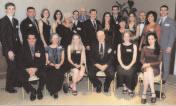

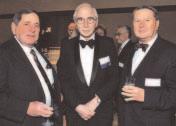


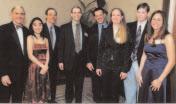
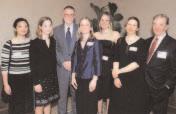
The 2003 Rush Shippen Huidekoper Society Dinner,which recognized Penn Veterinary Medicine’s most generous donors and friends during the 2002–03 fiscal year,was held on November 15 at The Inn at Penn.Named after the School’s first dean,the Rush Shippen Huidekoper Society recognizes those donors who contribute $1,000 or more to the School in a fiscal year.Their generosity advances Penn’s mission to better the health and welfare ofanimals and humans.
It was a wonderful evening as alumni,grateful clients,and other friends came together to celebrate the School’s teaching,research,and healing missions.The dinner also brought together Opportunity Scholarship recipients and their donors/mentors.
Class of 2006 Opportunity Scholarship Recipients and Donors/Mentors: Standing: James V.Stewart, V’68,Leslie C.McLaughlin,V’06,D.Ray Hostetter, V’69,Kristina N.Willoughby,V’06,Dean W.Richardson,Patrick J.Ford,V’06,Norbert R.McManus,V’47, Alexander M.Chan,V’06,Marilyn B.Weber,V’75, Midge Leitch,V’73,Jill Beech,V’72,Michelle H. Patrick,V’06,and Timothy Mann,V’06. Seated: Christie L.Schroth,V’06,Lauren M.Greene,V’06, Charles W.Raker,C’41,V’42,Nadine A.Salomon, V’06,Amanda L.Lang,V’06,and Kari Lyon,V’06.
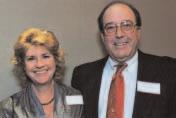
Class
and Donors/Mentors: Standing: Jonathan Garber, V’07,Craig Meredith,V’07,Heidi Reesink,V’07, Maryssa Chiarello,V’07,Ann Wayne Lucas,V’75, Isaac Maxmen,V’07,Mead F.Shaffer,Jr.,V’58,Scott E.Palmer,V’76,Taryn Gassert,V’07,Ryan Gorman, V’07,Mary McMahon Stewart,PT’66,Heather Wall, V’07,Robert W.Stewart,Sr.,V’68,Kelly Rebbecchi, and Joshua Roesener,V’07. Seated: Lawrence A. Rebbecchi,Jr.,V’90,Jill Beech,V’72,Tara O'Brien, V’07,Charles W.Raker,C’41,V’42,Rachel Ticktin, V’07,and Laura Gibeon,V’07.
Mark your calendar now!The 2004 Rush Shippen Huidekoper Society Dinner will be held November 20 at the National Constitution Center.For information, contact Joshua E.Liss at (215) 898-1481 or at lissj@vet.upenn.edu.
July 2004
25
6:30–8:30 p.m.
Alumni Reception
American Veterinary Medical Association Annual Convention
Loews Philadelphia Hotel,33rd Floor,Philadelphia,Pa. Complimentary for alumni with a Convention name badge and a guest;$10 for all others.For information,contact Joshua E.Liss at (215) 898-1481 or at lissj@vet.upenn.edu.
September 2004
10
2:00–4:00 p.m.
Veterinary Medical Alumni Society Executive Board Meeting Ryan Veterinary Hospital at Penn
Penn Veterinary Medicine Open House at New Bolton Center on September 18 has been postponed.
18
Parents and Partners Day 2004 Philadelphia Campus
Parents and partners offirst-year students receive an overview ofveterinary education at Penn Veterinary Medicine.For information,contact Amy Bogdanoff at (215) 898-4234 or via email at bogdanof@vet.upenn.edu.
October 2004
2 Alumni Weekend 2004
New Bolton Center
For information,visit <alumni.vet.upenn.edu/ alumniweekend2004.html>.
November 2004
6
Alumni & Friends Reception
New England Aquarium,Boston,Mass. For information,contact Amy Bogdanoffat (215) 898-4234 or at bogdanof@vet.upenn.edu.
17
2:00–4:00 p.m.
Veterinary Medical Alumni Society Executive Board Meeting New Bolton Center
20
2004 Rush Shippen Huidekoper Society Dinner National Constitution Center,Philadelphia,Pa. For information,contact Joshua E.Liss at (215) 8981481 or at lissj@vet.upenn.edu.
January 2005
8–15
Pennsylvania Farm Show 2005 Farm Show Complex,Harrisburg,Pa. Visit Penn Veterinary Medicine’s booth at the largest indoor agricultural event in America.
26
2:00–4:00 p.m.
Veterinary Medical Alumni Society Executive Board Meeting Ryan Veterinary Hospital at Penn
February 2005
21
7:30–9:30 p.m.
Alumni Reception Western Veterinary Conference Mandalay Bay Resort,Las Vegas,Nev. For information,contact Joshua E.Liss at (215) 8981481 or at lissj@vet.upenn.edu.
March 2005
10–11
2005 Penn Annual Conference
Adam’s Mark Hotel,Philadelphia,Pa. For information,visit <alumni.vet.upenn.edu/ pennannualconference.html>.
10
2:00–4:00 p.m.
Veterinary Medical Alumni Society Executive Board Meeting at 2005 Penn Annual Conference
May 2005
11
2:00–4:00 p.m.
Veterinary Medical Alumni Society Executive Board Meeting New Bolton Center
Important Phone Numbers
Matthew J.Ryan Veterinary Hospital of the University of Pennsylvania
Appointments(215)
George D.Widener Hospital for Large Animals at New Bolton Center
3800 Spruce Street
Philadelphia, PA 19104-6008
Address Service Requested